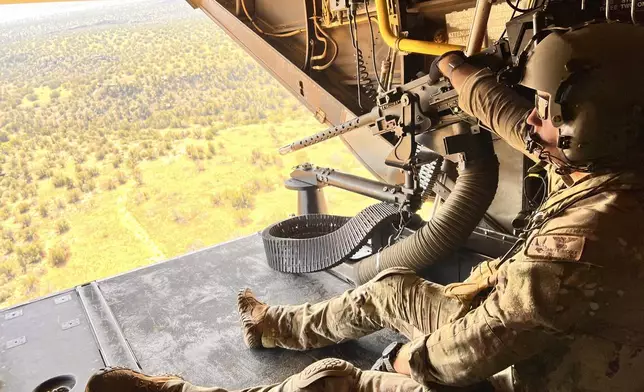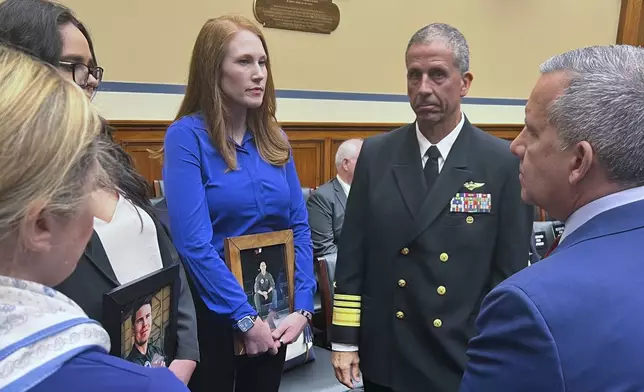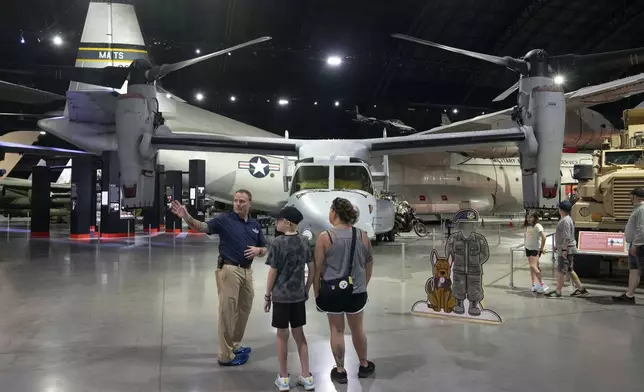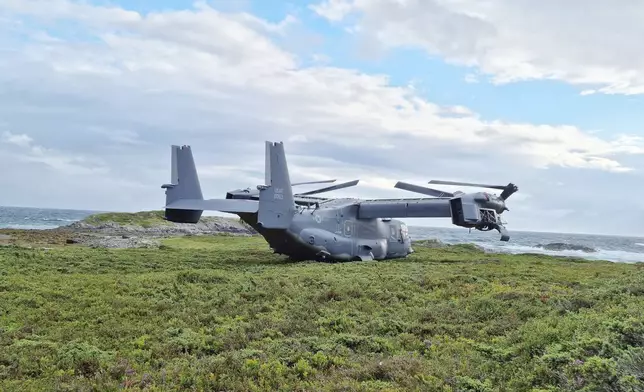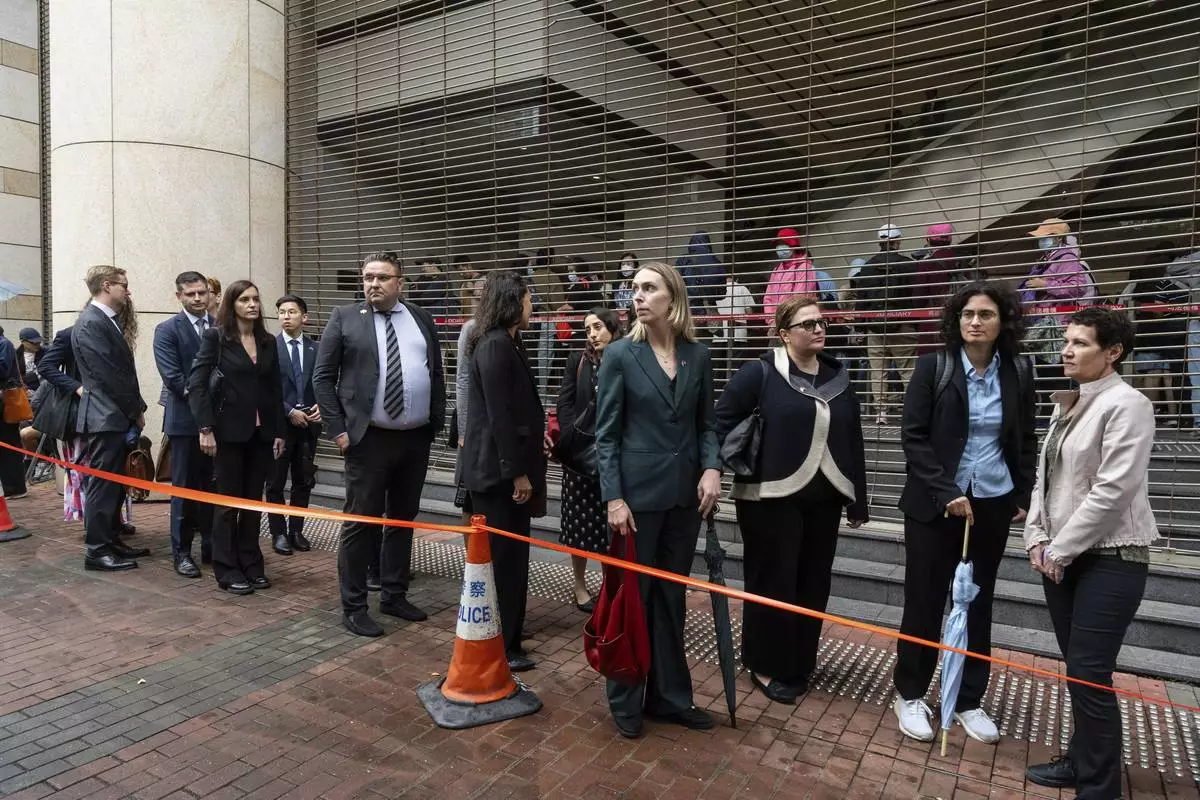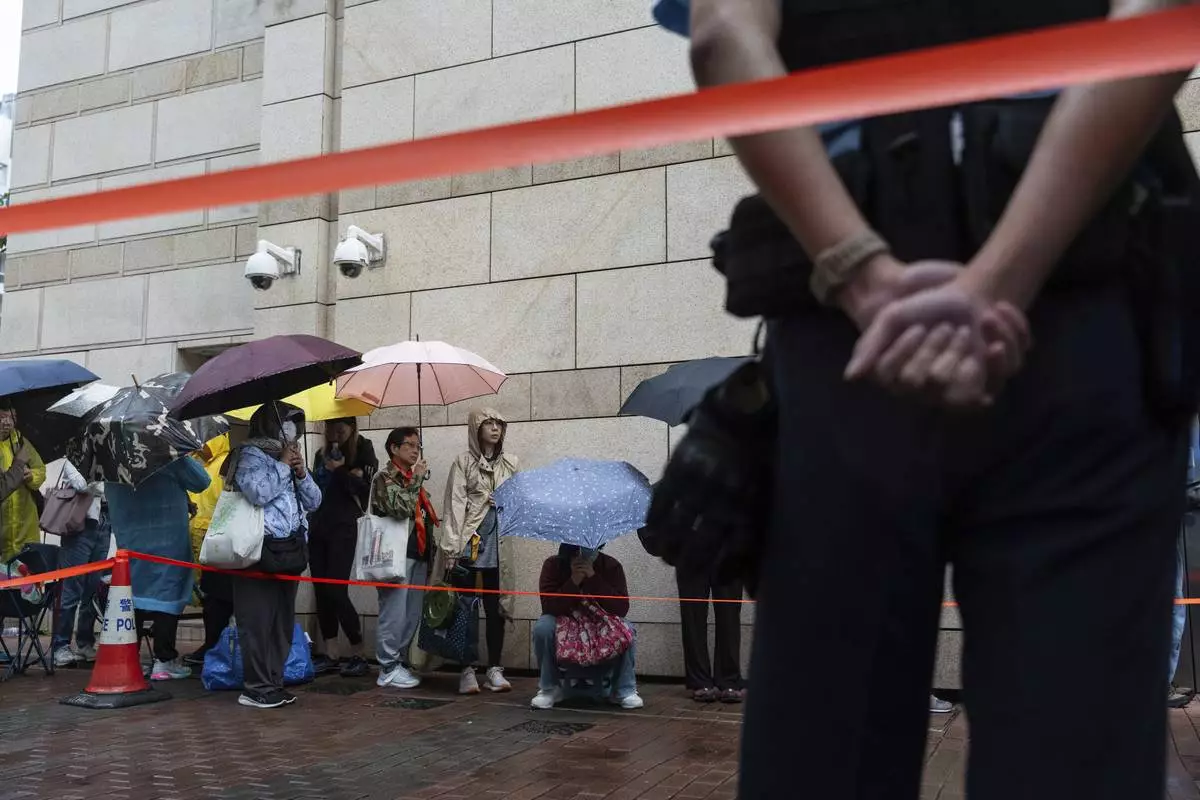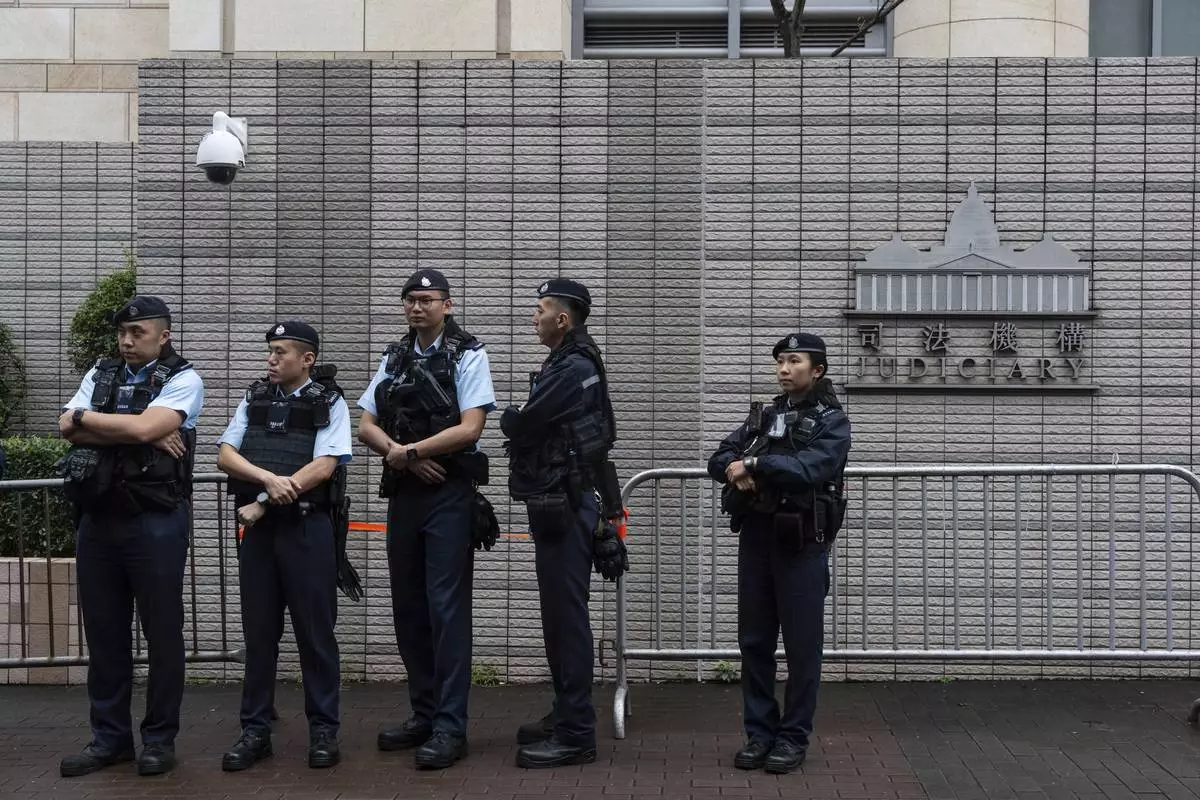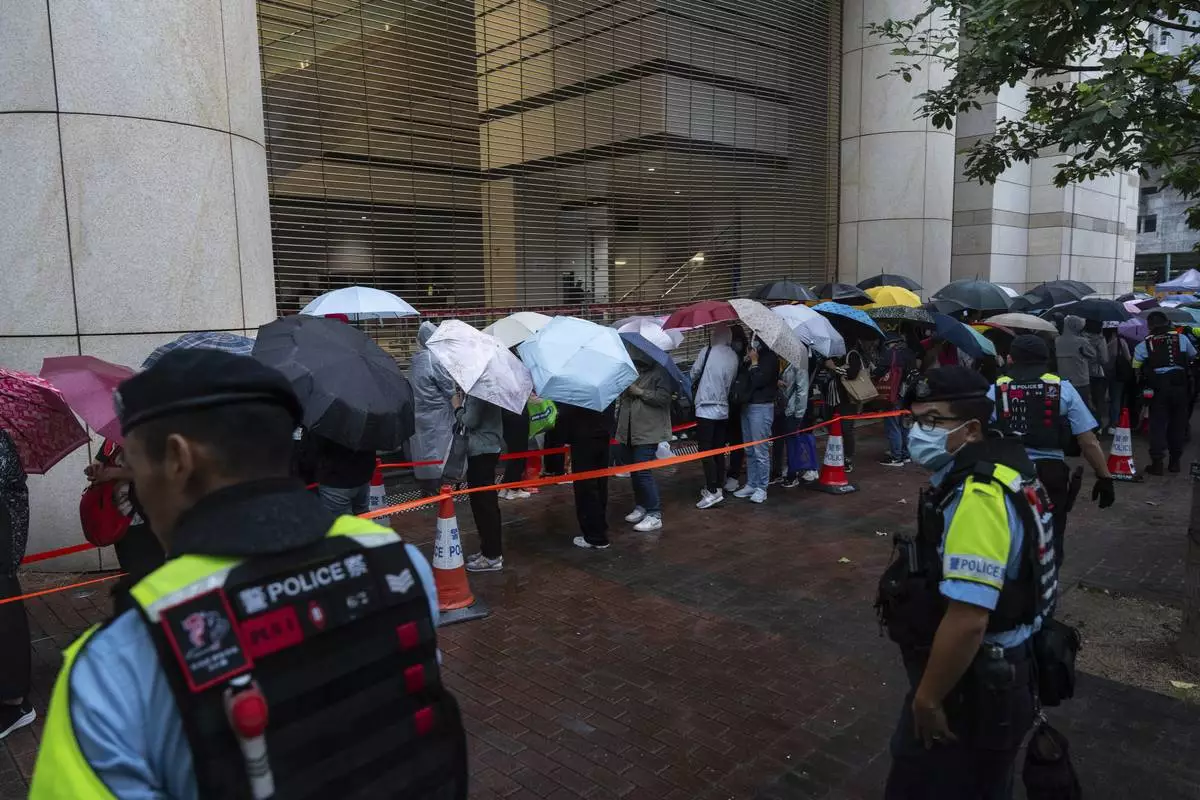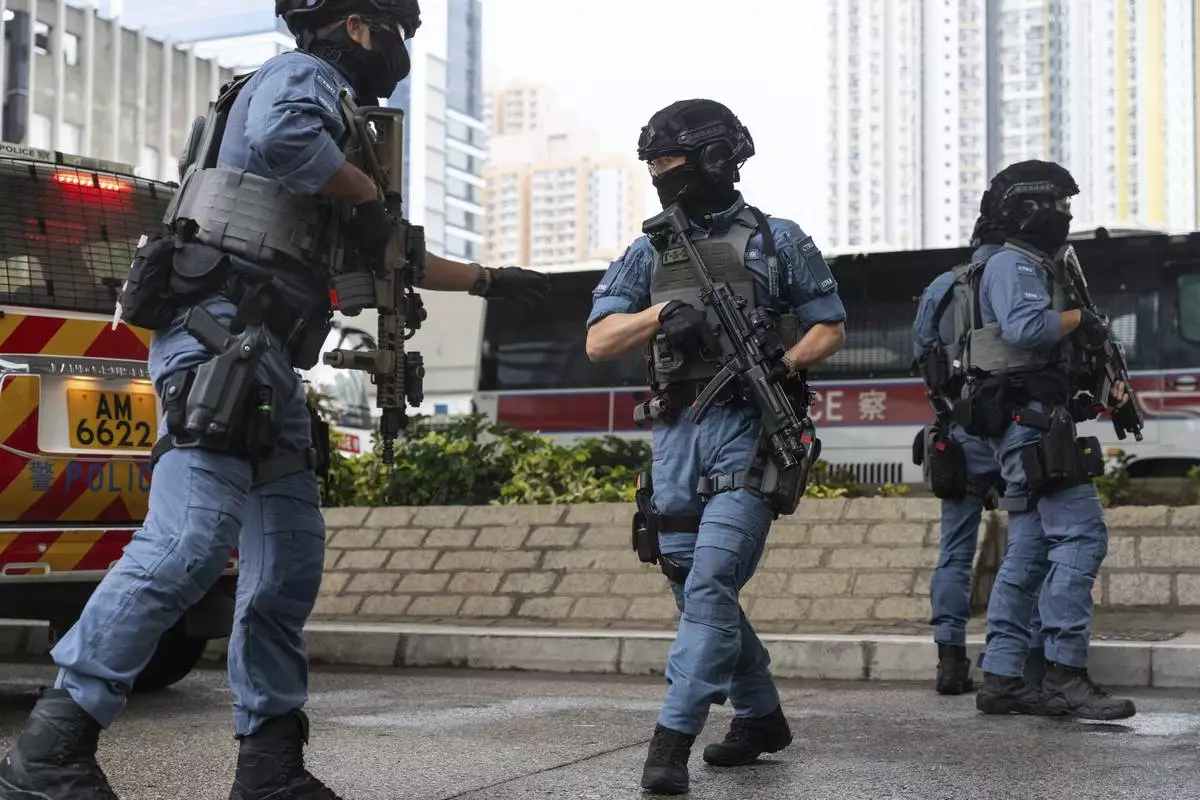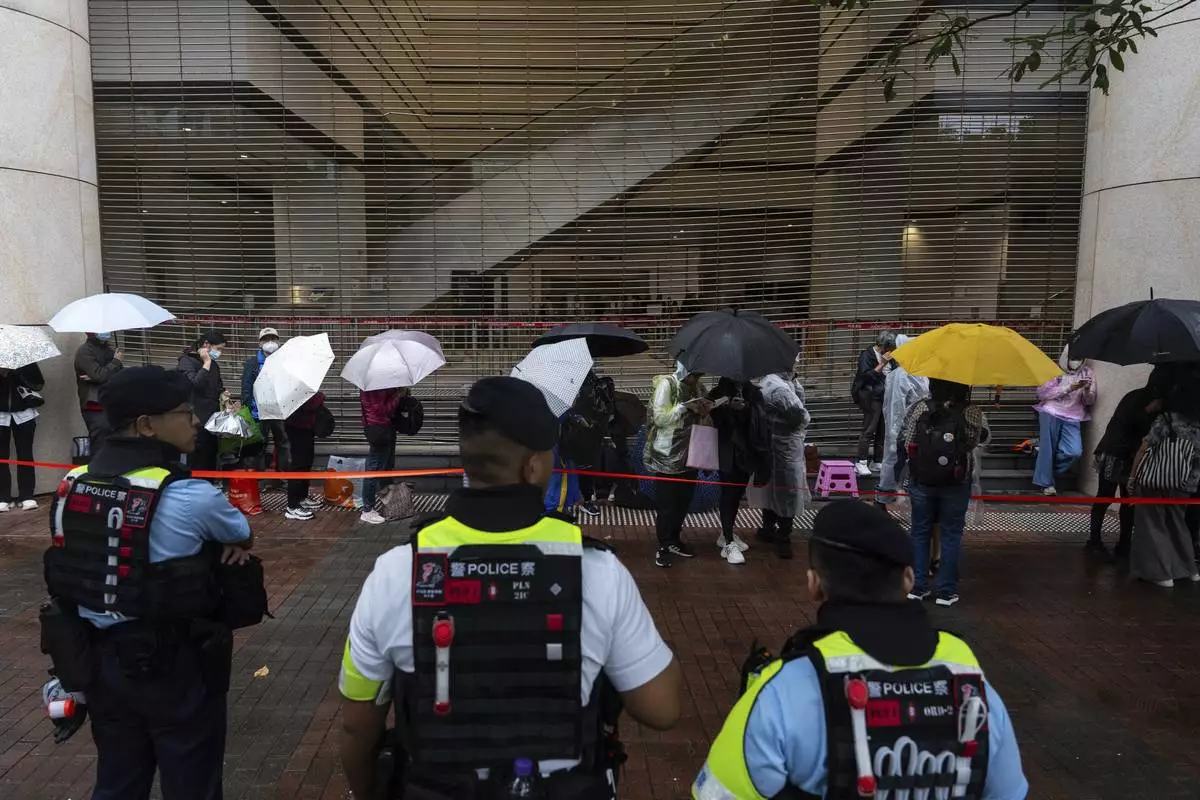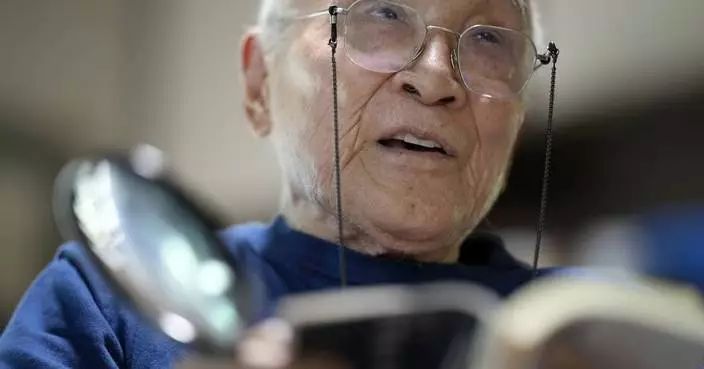CANNON AIR FORCE BASE, N.M. (AP) — Over a New Mexico training range named the Hornet, two Osprey aircraft speed 100 feet off the ground, banking hard over valleys and hills as they close in on a dusty landing zone.
A flight engineer in the back braces a .50-caliber machine gun over the edge of the Osprey's open ramp as desert shrubbery blurs past. The aircraft's joints shift and rattle, and there is little steady to hold on to until the Osprey touches down with a bump, flooding seats with rust-colored dust.
After being grounded for months following a crash last November that killed eight U.S. service members in Japan, the V-22 Osprey is back in the air. But there are still questions as to whether it should be.
The Pentagon bought the V-22 Osprey more than 30 years ago as a lethal hybrid, with the speed of an airplane and the maneuverability of a helicopter. Since then, 64 personnel have been killed and 93 injured in more than 21 major accidents.
Japan’s military briefly grounded its fleet again late last month after an Osprey tilted violently during takeoff and struck the ground. And four recent fatal crashes brought the program the closest it's come to being shut down by Congress.
To assess its safety, The Associated Press reviewed thousands of pages of accident reports and flight data obtained through the Freedom of Information Act, interviewed more than 50 current and former program officials, crew members and experts, and flew both simulator and real training flights.
The AP found that the top three most serious types of incidents rose 46% between 2019 and 2023, while overall safety issues jumped 18% in the same period before the fleet was grounded.
Yet current and former Osprey pilots — even those who have lost friends in accidents or been in crashes themselves — are some of the aircraft’s greatest defenders.
Ospreys have been deployed worldwide — landing in deserts and on ship decks, rescuing U.S. service members from ballistic missiles in Iraq, evacuating civilians in Niger and even standing by ready to protect the president during a surprise trip to Ukraine last year.
“There’s no other platform out there that can do what the V-22 can do,” said former Osprey pilot Brian Luce, who has survived two crashes. “When everything is going well, it is amazing. But when it’s not, it’s unforgiving.”
Unlike other aircraft, the Osprey’s problems have not leveled off as the years passed, instead they spiked — even as the number of hours flown have dropped. Many of those incidents can be directly tied to the aircraft’s design, experts said.
Parts are wearing out faster than planned, and it's so complex that a minor mistake by a pilot can turn deadly.
While some aspects of the Osprey are now getting modified to make it more reliable, it’s unlikely the Osprey's core design will change. With about 400 aircraft that cost between $75 million and $90 million apiece, a major upgrade to the fleet could cost billions.
In 2010, Luce was the co-pilot in an Osprey crash in Afghanistan that killed his aircraft commander, flight engineer, an Army Ranger and a translator.
There was no enemy fire. In the final seconds of flight, as the Osprey converted to land like a helicopter, it dropped at a rate of more than 1,800 feet per minute. The crash investigation was inconclusive but found possible crew errors and said the engines may have lost power from sucking in too much dust.
Two years later, Luce was the aircraft commander overseeing a co-pilot on a Florida training range. Luce’s aircraft was flying low to the ground and about 750 feet behind the lead Osprey — three times the safe minimum distance required.
Despite being football fields apart, when both Ospreys banked, their change in position put one of Luce’s rotor blades inside the 25-foot vertical separation they needed. It crossed into the wake of the lead aircraft — a turbulent and unpredictable wash of air so strong that crews nicknamed it “Superman’s cape.”
In seconds, Luce’s Osprey nearly inverted and began dropping at more than 2,800 feet per minute before crashing and catching fire.
All five crew members survived. As the most seriously injured were airlifted out, Luce called his wife at the time, his voice shaking.
“It happened again,” he said.
She did not have to ask what he meant.
Both the 2010 and 2012 crashes exposed issues with the Osprey that the military still faces today.
After Luce’s 2012 crash, Osprey pilots warned investigators that the program was in trouble, according to investigation interviews obtained by the AP. Pilots couldn’t get enough training hours. Ground maintenance crews couldn’t keep enough aircraft flying due to a shortage of parts.
To meet cost and schedule targets, the Pentagon's Osprey program office allowed manufacturers Bell Flight and Boeing to turn the Osprey over to the military without fully identifying all the ways the aircraft could run into trouble, a 2001 Government Accountability Office report found.
So even by Luce's 2012 crash, the military still didn't know the full size of the Osprey's wake, crash investigators found.
“The fact that they fell out of the sky just defies logic," Luce's commander Lt. Col. Matt Glover told crash investigators in documents reviewed by the AP.
“I wish I could say there’s not going to be a next one, but where we are right now, is it ‘if’ or ‘when,’” said a second pilot, who was flying the Osprey in front of Luce’s and whose name is redacted.
The Osprey's safety record has been challenged in multiple congressional hearings over the years. But each time, it has returned to flight. Some members of Congress have said there is no more margin for error.
“If another Osprey goes down, we’re done. This program’s done,” Rep. Stephen Lynch, a Massachusetts Democrat, told Osprey program officials during a hearing this spring.
In the 1980s, when the $56 billion V-22 program was in its early stages for Bell Flight and Boeing, the Marine Corps controlled the Osprey’s final design because it committed to buying the most. The Marines wanted an aircraft that could carry at least 24 troops, but only take the same small space on a ship deck as the CH-46 helicopter, which the Osprey was replacing.
Experts say design choices have affected the Osprey’s safety since:
— The Osprey’s proprotors, which work as propellers while flying like an airplane and as rotor blades when functioning as a helicopter, are too small in diameter for the aircraft’s weight, which can top out at 60,500 pounds.
— The Osprey’s entire engine, transmission and proprotors rotate to a vertical position when it flies like a helicopter, which compromises the engines.
— That vertical rotation is at the core of what makes the Osprey complex. Crews must watch numerous factors: speed, the angles of the engine and rotor blades, and the up or down position of the aircraft's nose, related to the Osprey's weight and center of gravity to keep it from crashing.
The Osprey is twice as heavy as the CH-46, so the rotor blades needed to be longer but couldn’t be because they would have hit the body of the aircraft or the tower on the ship deck. Instead, the Osprey’s engines had to be more powerful to help the shorter blades generate enough lift.
That creates fast, violent airflow through the rotor blades, which can quickly destabilize the Osprey if one engine has more power than the other.
More powerful engines also meant they would weigh more. So engineers designed them to rotate and used their exhaust thrust to help lift the Osprey off the ground.
“It’s an aircraft with a huge amount of performance packed into a very compact space. What that means is that it’s a real hot rod to fly,” said Richard Brown, a rotorcraft specialist at Sophrodyne Aerospace. "But it also has these foibles which are baked into the design.”
Problems with the vertical engine caused the aircraft’s first fatal accident in 1992. Oils that had pooled while the Osprey was flying like an airplane spilled down into the engine as it rotated to a vertical helicopter position, catching fire and killing seven crew.
In December 2000, repeated transitions to helicopter mode — where the engine and rotor blades rotate upward like an elbow joint — wore down one of the hydraulic lines in an Osprey to the point that it ruptured in flight, killing four Marines. That led to a grounding and system redesign.
Dusty landings present added danger. When the Osprey hovers in helicopter mode, the air and exhaust it creates can kick up a wall of dust and debris that can get sucked back into the engines, clogging and degrading them.
In 2015, a Marine Corps Osprey hovering for 45 seconds in Hawaii disturbed so much sand and dust the crew had to abort and try again to land, because they could no longer see. On their second attempt, the Osprey’s left engine stalled and the aircraft dropped flat, killing two Marines.
“I heard what sounded like the entire aircrew yelling ‘power, power, power,’” a surviving Marine told investigators, according to redacted interviews obtained by the AP. “The ceiling opened like a sardine can.”
After the accident, the Marine Corps put out new guidelines reducing the amount of time the aircraft could hover in dusty environments.
But two years later, dust was a factor again. Pilots of a Marine Corps Osprey that had been dropping off troops in landing zones in Australia all day were concerned enough about the aircraft's weight and potential accumulated dust in the engines that they wanted troops to pour out their water jugs to cut weight.
On their final flight, as the Osprey neared the deck of the transport ship USS Green Bay, it dropped. Airflow generated by the Osprey had reflected off the ship deck and backed up through the rotors.
The pilots applied full throttle but the engines could not produce enough power to compensate for the loss. The Osprey kept falling, clipped the side of the ship and fell into the ocean, killing three.
“It just felt like there was nothing you could do,” the lead pilot told investigators. “I don’t recall seeing anything with the gauges at this point. I just remember being very frightened.”
The Osprey’s manufacturers, Bell Flight and Boeing, both referred questions about whether design changes could be made to either the rotors or engine orientation to the Pentagon.
In a statement to the AP, Bell said it took the heavier loads into account in its aircraft.
“While the capabilities of the Osprey have evolved over the years, the envelope of the aircraft based on configuration to support the varied missions has actually not adjusted significantly and was anticipated by the original design,” Bell said.
The Osprey’s design strains critical components inside, especially in helicopter mode — and those parts are wearing out faster than expected.
When the Osprey is flying like a helicopter, everything has to work harder, because the engines and rotors are supporting the full weight of the aircraft. In airplane mode, the rotors only have to overcome the aircraft’s drag, said Brown, the rotorcraft expert.
Air Force crews fly the heaviest Osprey variant because of all the special instruments needed to allow it to fly secret missions, such as conducting rescues or inserting special operations forces in hostile territory.
In helicopter mode, they have to use an option called “interim power” to land safely, said Glover, the former Osprey squadron commander. The option surges more power, but that also can overtax the gears in the Osprey’s transmission, known as the proprotor gearbox.
“Bell-Boeing and the Marines had said: ‘Hey, you’re not supposed to use that thing very often. We don’t recommend it.’ Well, the Air Force, we’ve got to use it because we are heavy,” Glover said. “If you don’t use it, you won’t have the power to land.”
Japan's defense ministry blamed human error for its most recent accident, where the Osprey tilted and struck the ground, because the pilots did not engage the interim power option as they hovered like a helicopter during takeoff. The ministry announced last week that its Ospreys had been cleared to return to flight.
The strain from helicopter mode shows in the Osprey’s transmission. A total of 609 have had to be replaced in the past 10 years, according to data obtained by the AP.
Wear and tear also puts a large demand on ground maintenance crews, who closely track components in the aircraft’s drive system to monitor strain. After each flight, they examine the Osprey’s engines, transmission and hydraulic lines for signs of stress.
On the hydraulic lines, “if one of those comes loose, it’s a problem,” said Master Sgt. Frank Williams, an Osprey maintenance supervisor at Cannon Air Force Base. “You have to pay attention.”
In response to questions from the AP, the Marine Corps said the Osprey is still one of its safest aircraft. Over the past decade, the rate that it experienced the worst type of accident resulting in either death or loss of aircraft was 2.27 for every 100,000 hours of flight. The Marines said that compares with 5.66 for its other heavy lift helicopter, the CH-53.
Those numbers don’t tell the whole story. The Marines’ three most serious categories of accidents climbed from 2019 to 2023, even as the number of hours they flew dropped significantly — from 50,807 in fiscal 2019 to 37,670 in 2023, according to data obtained by the AP.
The Air Force’s Osprey has a much higher rate of the worst type of accidents per 100,000 flight hours than its other major aircraft, and its incidents also climbed even as flight hours dropped.
The AP also found that the rise in safety problems over the past five years largely involved the Osprey’s engine or drive system.
There were at least 35 instances where crews experienced an engine fire, power loss or stall, 42 issues involving the proprotors and at least 72 instances of the gears inside the transmission or drive system becoming so stressed they flake off metal chips that can quickly endanger a flight.
The Osprey’s complexity tests its crews.
Pilots control the angle of the engines and proprotors with a small notched wheel they move with their thumbs. It’s sensitive to the touch — too much of a nudge and the engines’ angle changes by several degrees. And they have to watch a computer display to see the angle.
As the engines and rotor blades begin to rotate upward, the flight controls inside the cockpit change, too — from working like the controls inside an airplane to operating like those in a helicopter.
“You have to just mentally switch, while you are on approach, what your hands are doing,” said Osprey pilot Capt. Christian Eells.
The aircraft's computer is designed to autocorrect for a pilot if their movement of the wheel could result in the Osprey's internal components being damaged. But that adds to the danger if a pilot can't quickly force the nacelles, which house the engines, upward to slow down the aircraft, he said.
“It will not prevent you from stalling, sinking rapidly or entering any other unsafe flight,” Luce said. “But if you are going too fast, it will not only prevent you from raising the nacelles to slow down, the flight control computers will bounce the nacelles forward" to reduce strain on the gears — which speeds the Osprey up, Luce said.
If there are other complications in flight or a pilot is distracted or misses the significance of an aircraft warning light, those mistakes can turn dangerous quickly.
Lt. Col. Seth Buckley, the 20th Special Operations Squadron commander at the Cannon base, acknowledged that he puts a lot of pressure on his crews to be perfect.
“You have to take that mindset because there are so many things you can do in this aircraft to induce worse problems,” Buckley said.
Reminders of why hang inside the squadron’s heritage room at Cannon, where they have put up a wooden memorial plaque with eight upside-down shot glasses for the friends they lost last November in Japan.
Many of them also wear black metallic memorial bands on their wrists, with the Nov. 29, 2023, crash date and the Osprey’s call sign, “Gundam 22,” etched in.
The most recent accidents have spurred new lawsuits and congressional investigations.
Family members of the five Marines killed in a 2022 crash in California, caused by an unprecedented dual failure of the Osprey's clutch, are suing Bell and Boeing, and the maker of the engines, Rolls-Royce. Some of the families of the eight Air Force members killed last November in the Japan crash, which was caused in part by weakened metals in a critical transmission gear, also have hired a lawyer.
“Ultimately, the goal is an Osprey that is as airworthy and in as safe a condition as possible,” said attorney Tim Loranger, who is representing the families.
Following the Japan crash, the military grounded the fleet for three months. Congress also was investigating, and there was frustration from some lawmakers that the Osprey returned to flight before those reviews were complete.
In the meantime, it’s been difficult to get a clear picture of how the aircraft’s manufacturers are responding. After investigations into the Japan and Australia crashes were released this year, neither Bell Flight nor Boeing commented, citing pending litigation.
Naval Air Systems Command, or NAVAIR, which runs the joint Air Force, Marine Corps and Navy Osprey program, is working on a variety of upgrades that should make the aircraft easier to maintain and looking at how else the program can be improved.
“This is the appropriate time to be looking at systemic improvements to the platform,” former program manager Marine Corps Col. Brian Taylor said in a statement.
But it’s unlikely to change any of the fundamentals of vertical engines or rotor size. Those problems are getting fixed in a new aircraft called the Valor that Bell Flight is selling to the Army.
The Valor looks a lot like the Osprey, but it’s smaller. The Valor’s engines stay in a horizontal position. Its smaller size means the rotor blades are more proportional with the aircraft’s weight, which reduces strain on all the other components.
The Valor “captured many lessons learned from both tiltrotor and helicopter previous experience,” Bell said in a statement.
Air Force leadership is watching the Osprey closely, investing in improvements to the engine to make it easier to maintain and looking at future alternatives. The Navy has taken steps to keep more of its legacy aircraft carrier transport planes around in case it can’t make the Osprey work.
The Marine Corps is committed to flying its hundreds of Ospreys through 2050. But it’s also doing a study to decide whether to “significantly modernize the MV/22 and/or begin the process to move forward” to a next-generation assault aircraft, Lt. Gen. Bradford Gering, Marine deputy commandant of aviation, said in a statement.
Until it has a new option, the Air Force is looking at what can be done to ensure pilots get the time and training needed to master the Osprey, Air Force special operations commander Lt. Gen. Michael Conley said.
“What I don’t want is someone in my seat 10 years from now say, ‘You know back in 2010, 2012, 2024, you knew crews weren’t getting enough flight hours, you knew there were maintenance challenges, and here we are having the same discussion,’” Conley said.
But it’s also about realizing that aspects of how the Osprey flies won’t change, said Buckley, the Cannon Osprey squadron commander.
“What you have to do is reduce your exposure,” Buckley said.
For example, simulators can now model the full “Superman’s cape” phenomenon, and crews can train to it. But there are still unknowns.
“I do think that we’re still — and maybe even to this day — to a degree working through all the ins and outs aerodynamically what is different about this that has never been seen before with any other aircraft,” Buckley said.
But that doesn’t mean ground it, he said.
In Iraq, Buckley flew a mission where the Osprey was the only aircraft that could help save a service member’s life after a vehicle rollover.
“There wasn’t another plane flying in the sky because the weather was so bad,” Buckley said. “We flew up and down the line of the haboob trying to get around it, but the lightning was too bad, so we penetrated.”
“To this day, that guy is with his family,” he said.
Buckley understands the risks in a different way than many of his crews. He was a high school senior when his 25-year-old brother, 1st Lt. Nathaniel D. Buckley, died in an AFSOC MC-130H cargo aircraft crash in 2002.
In his office, Buckley pointed to the American flag that the Air Force presented to his family after his brother’s death.
“I think my job here is to ensure that I’m going to push it to the level that we are making sure we aren’t delivering any more of these,” he said.
Vineys and Kessler reported from Washington. AP reporter Mari Yamaguchi contributed from Tokyo.
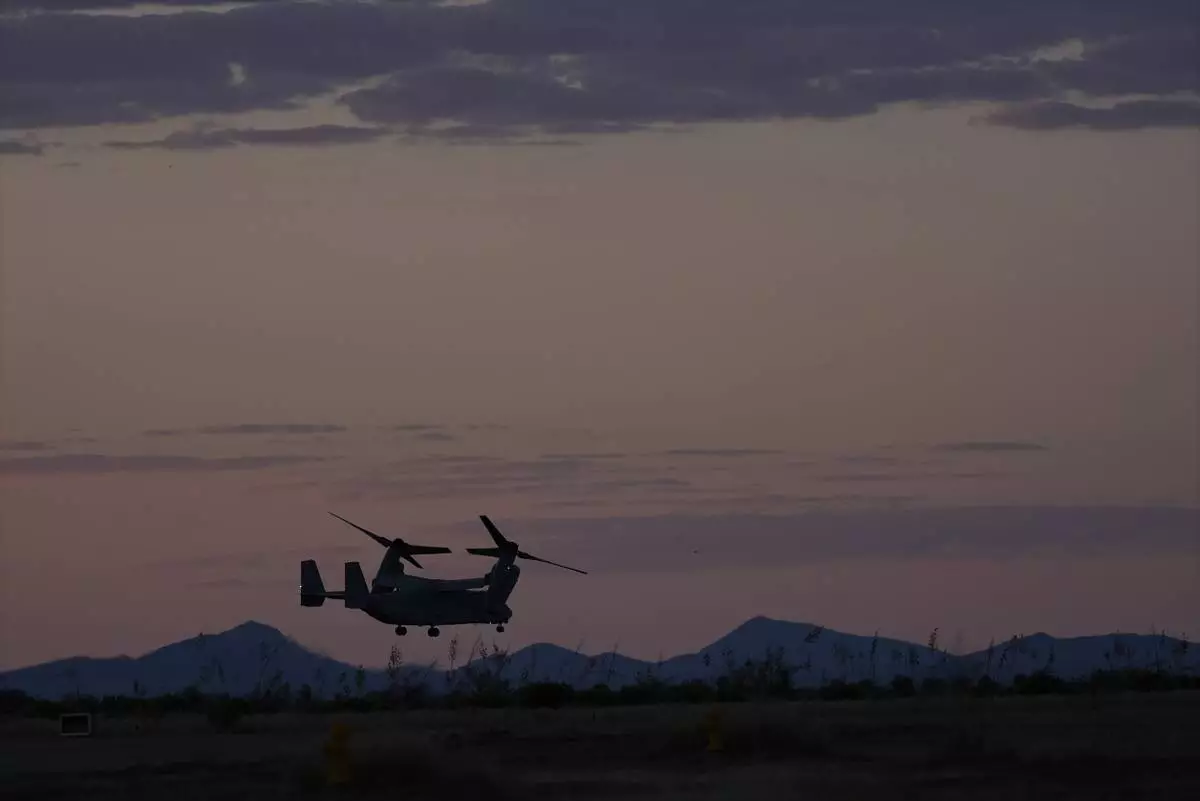
FILE - Marine Two, an Osprey tilt-rotor aircraft, with Democratic presidential nominee Vice President Kamala Harris aboard, departs after she visited the border and spoke in Douglas, Ariz., Sept. 27, 2024. (AP Photo/Carolyn Kaster, File)
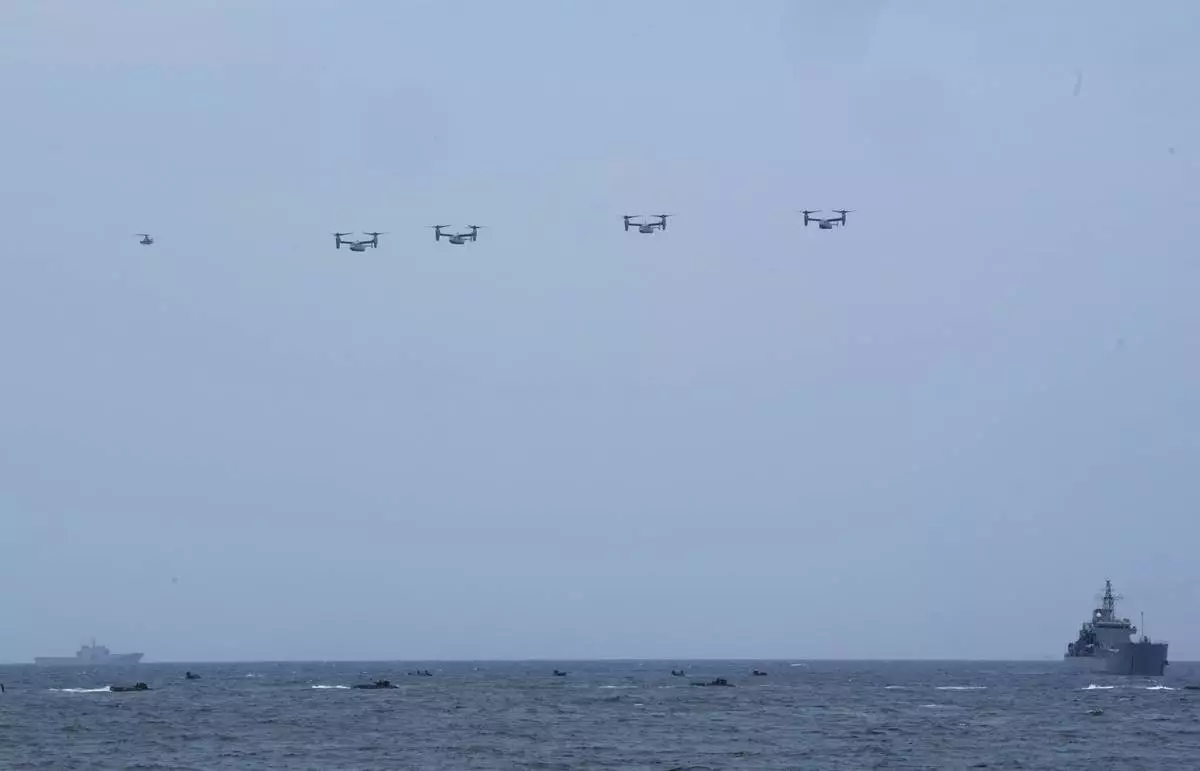
FILE - U.S. Osprey transport aircraft participate in the combined military amphibious landing exercise between South Korea and the U.S., called Ssangyong exercise, in Pohang, South Korea, Sept. 2, 2024. (AP Photo/Ahn Young-joon)

Wreckage from a V-22 Osprey that crashed during NATO exercise Cold Response is seen in Beiarn, Norway, April 4, 2022. The bodies of four Marines who died in a military aircraft crash during a NATO exercise have been transferred back to the U.S. The U.S. Marine Corps said an Osprey aircraft crashed on March 18 in a Norwegian town in the Arctic Circle, killing the four Marines. (Cornelius Poppe/NTB Scanpix via AP, File)

Osprey flight engineer Tech Sgt. Brett McGee sits on the back open ramp of the V-22 and holds the aircraft's .50 caliber gun as the crew flies over a New Mexico training range Oct. 9, 2024, near Cannon Air Force Base. (AP Photo/Tara Copp)
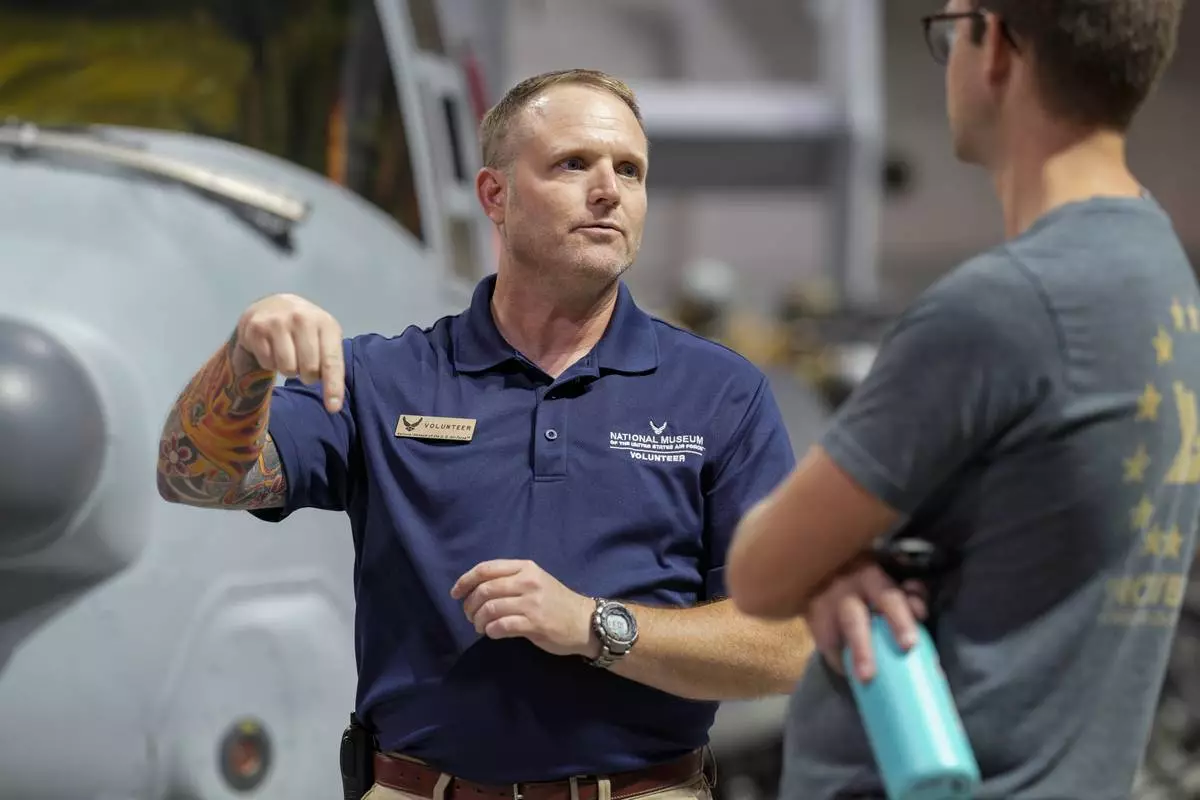
Brian Luce, left, speaks with museum visitor Ben Perkins inside of the Wright Patterson AFB Air Force Museum, Friday, Aug. 9, 2024, in Dayton, Ohio. (AP Photo/Jeff Dean)
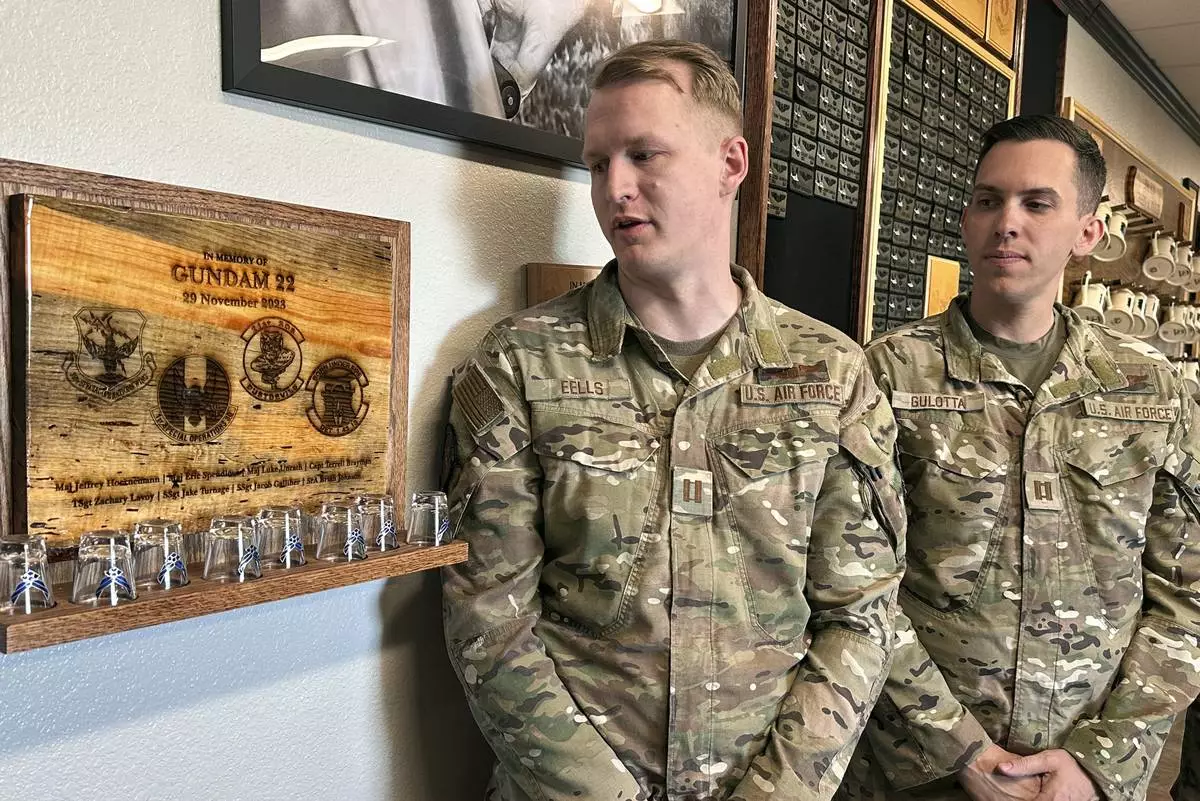
Osprey pilots Capt. Christian Eells, left, and Capt. Matthew Gulotta stand Oct. 8, 2024, at Cannon Air Force Base, N.M., beside a memorial to the Air Force Special Operations Command Osprey callsign "Gundam 22" that crashed off the coast of Japan in November 2023, killing all eight service members aboard. (AP Photo/Tara Copp)
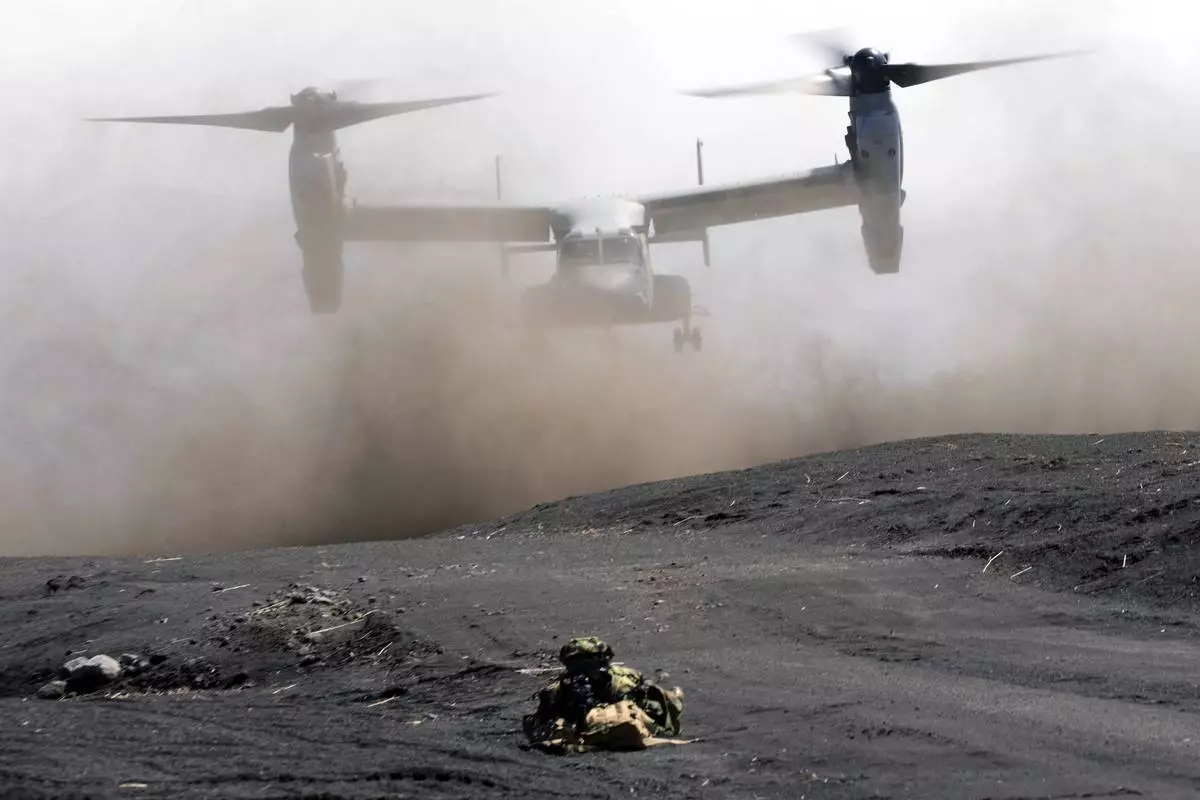
FILE - An MV-22 Osprey takes off as Japan Ground Self-Defense Force guards the landing zone during a joint military drill with U.S. Marines in Gotemba, southwest of Tokyo, March 15, 2022. (AP Photo/Eugene Hoshiko, File)

FILE - Amber Sax, center, holds a photo of her late husband, Marine Corps MV-22B pilot Capt. John Sax, as she and other family members who have lost service members to Osprey crashes talk with Vice Adm. Carl Chebi, Commander of U.S. Naval Air Systems Command, center right, and Peter Belk, acting Assistant Secretary of Defense for Readiness, right, before a hearing on the programs safety record, Wednesday, June 12, 2024, on Capitol Hill in Washington. (AP Photo/Tara Copp)
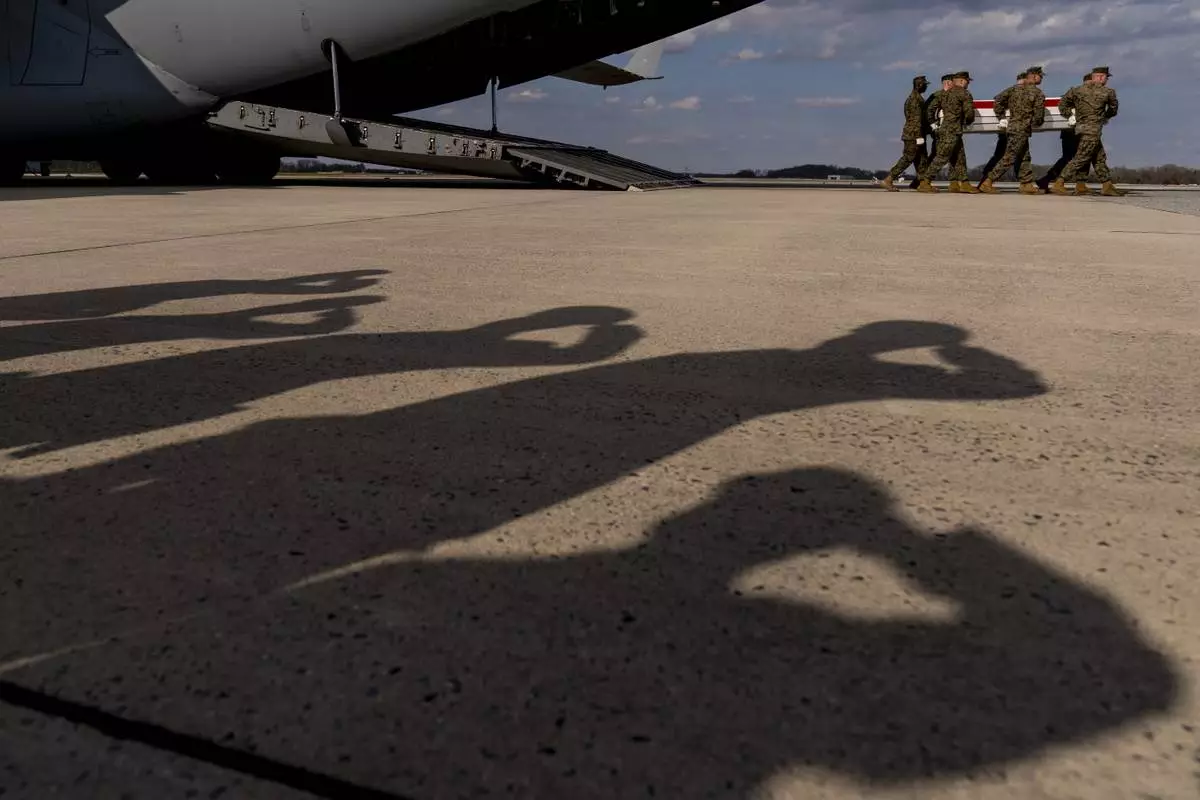
FILE - A U.S. Marine Corps carry team moves a transfer case containing the remains of Gunnery Sgt. James W. Speedy of Cambridge, Ohio, during a casualty return, Friday, March 25, 2022, at Dover Air Force Base. According to the Department of Defense, Speedy died March 18, in an Osprey crash during a NATO exercise in Norway. (AP Photo/Andrew Harnik)
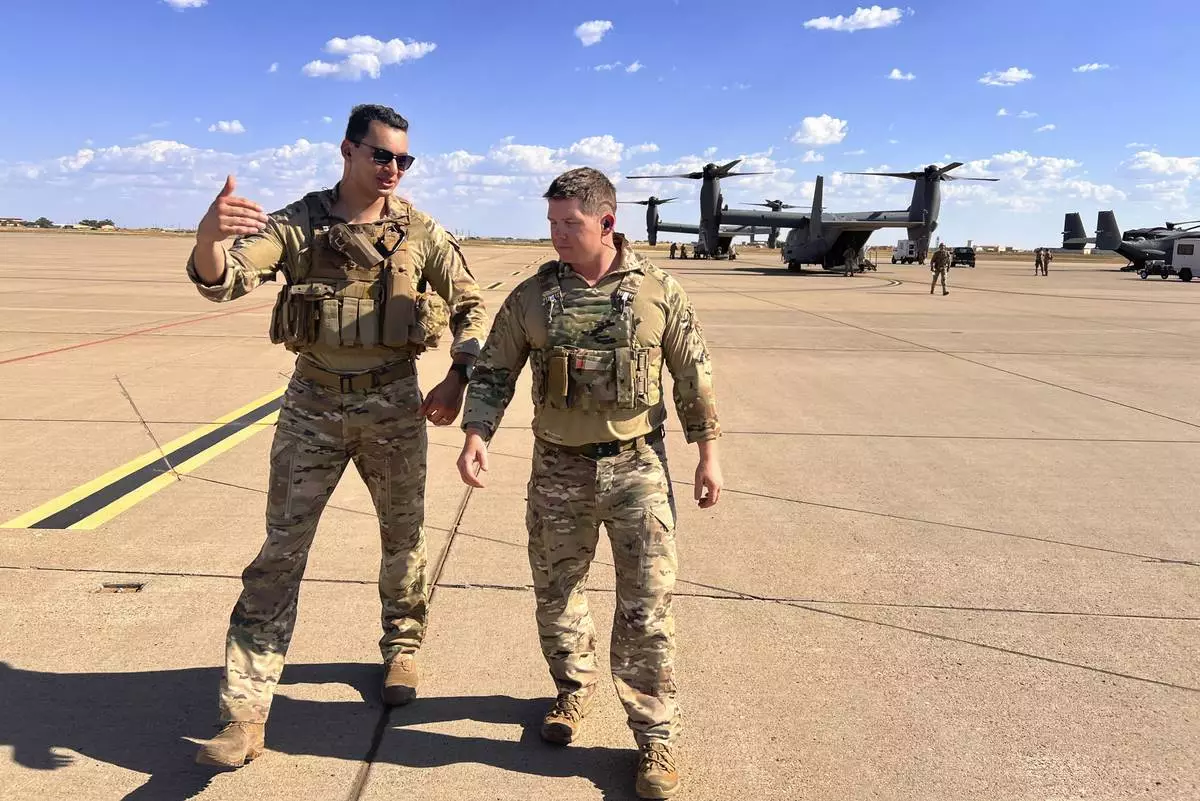
Osprey pilot Maj. Lucas Duncavage and squadron commander Lt. Col. Seth Buckley talk over their V-22 Osprey training flight just after landing, at Cannon Air Force Base, N.M., Oct. 9, 2024. During the flight they sped 100 feet off the ground on a training range named the Hornet. (AP Photo/Tara Copp)
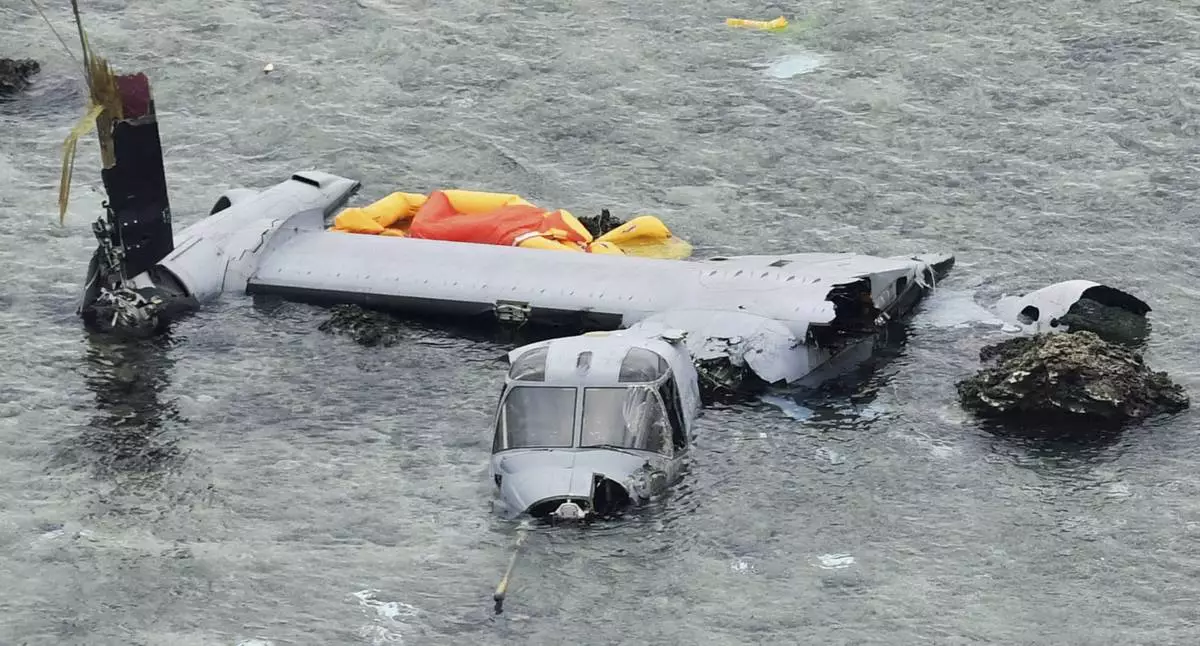
FILE - Wreckage of a U.S. military MV-22 Osprey is seen in shallow waters off Nago, Okinawa, southern Japan, Dec. 14, 2016, after it crash landed. (Yu Nakajima/Kyodo News via AP, File)

Former Air Force Osprey pilot Brian Luce, left, speaks with museum visitors inside of the Wright Patterson AFB Air Force Museum, Aug. 9, 2024, in Dayton, Ohio. (AP Photo/Jeff Dean)

A Boeing V-22 Osprey is seen on Aug. 13, 2022, in Senja, Norway, after an emergency landing due to a clutch issue. (Norwegian Armed Forces via AP)
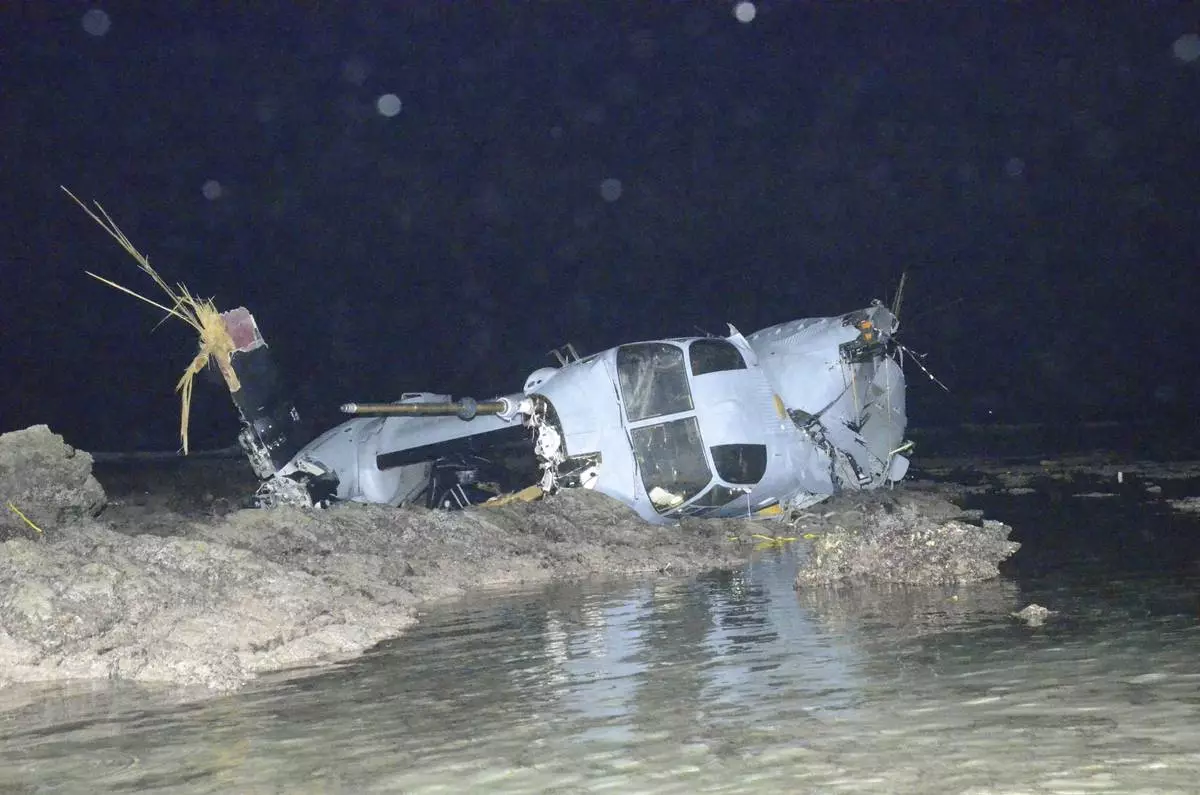
FILE - Wreckage of a MV-22 Osprey is seen in shallow waters off Nago, Okinawa, southern Japan, Dec. 14, 2016, after it crash landed. All five crew members were safely rescued. (Ryukyu Shimpo/Kyodo News via AP)
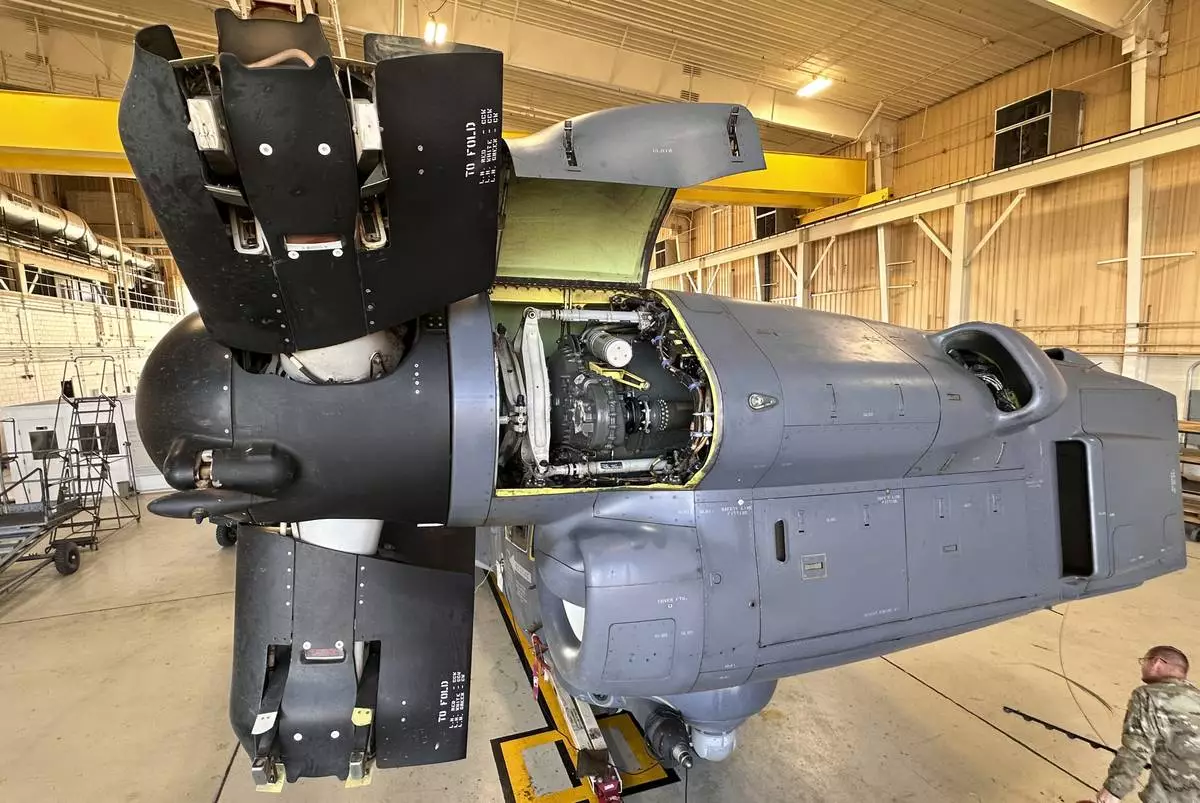
A service member walks under the Osprey nacelle, which houses both the Osprey's engine and transmission system and bends upward like an elbow during vertical flight at Cannon Air Force Base, N.M., Oct. 8, 2024. The open panel shows the proprotor gearbox, which serves as the transmission and has been a factor in multiple crashes after parts wore down and broke apart in flight. (AP Photo/Tara Copp)
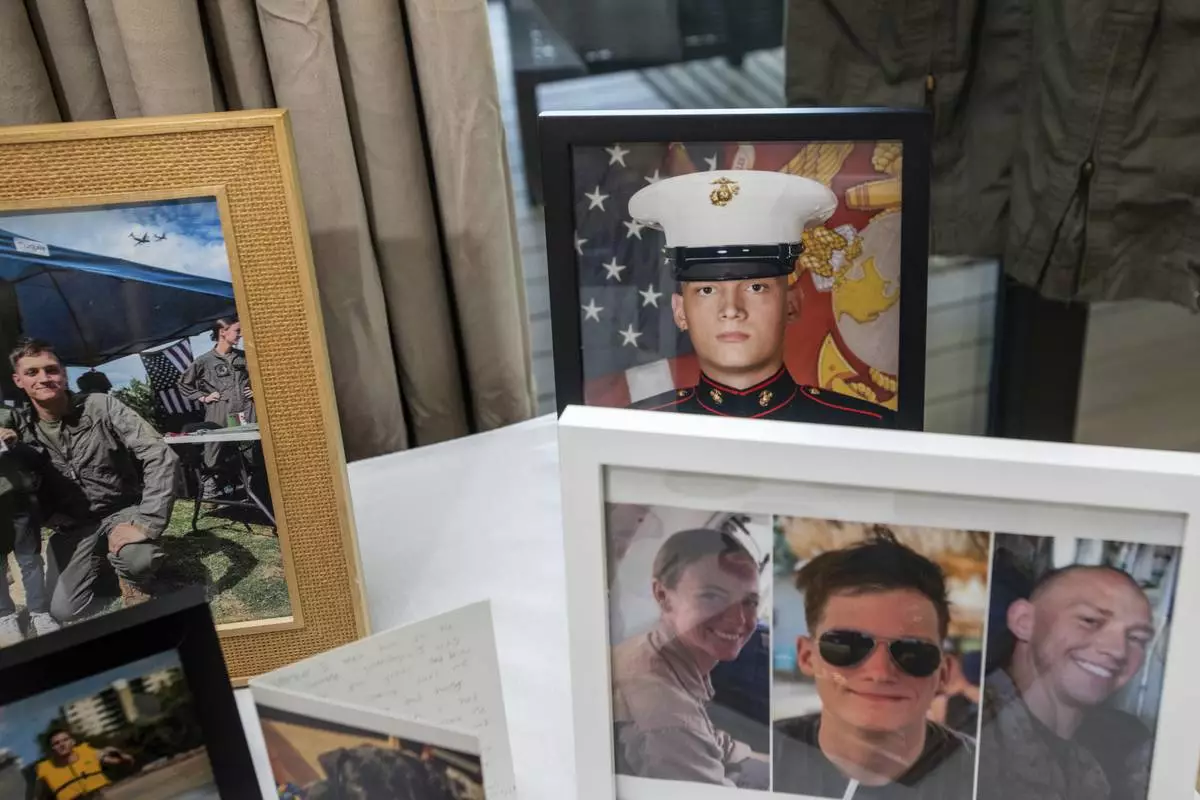
FILE - Photographs of Marine Cpl. Spencer R. Collart and his fellow marines, Capt. Eleanor V. LeBeau, bottom left, and Maj. Tobin J. Lewis, bottom right, are seen at the home of his parents in Arlington, Va., June 19, 2024. Collart, 21, was killed along with the two Marines when the MV-22B Osprey aircraft they were on crashed during drills on a north Australian island on Aug. 27, 2023. (AP Photo/Rod Lamkey, Jr.)
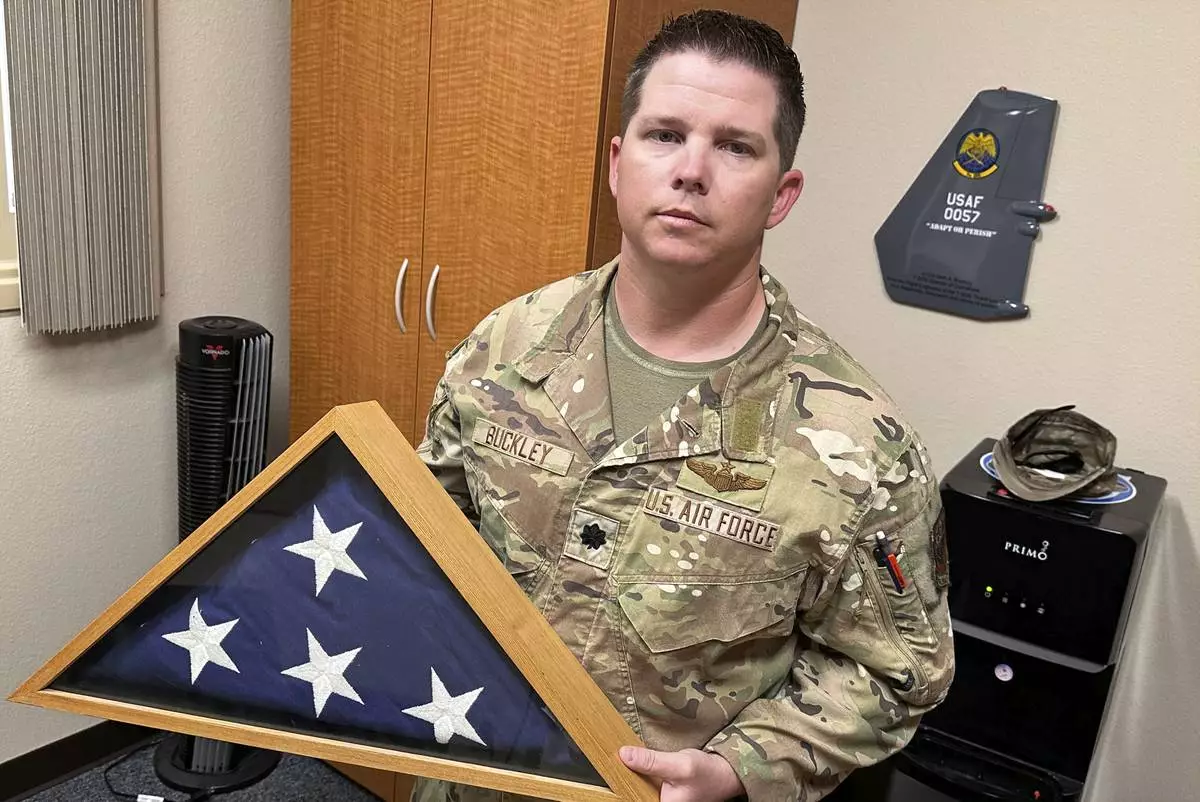
Lt. Col. Seth Buckley, an Osprey squadron commander at Cannon Air Force Base, N.M., who lost his brother in an Air Force Special Operations Command MC-130H crash (AFSOC) when he was still in high school, poses for a photo in his office Oct. 8, 2024.. Buckley says, "I think my job here is to ensure that I'm going to push it to the level that we are making sure we aren't delivering any more of these," he said of the flag the Air Force gave his family, which he keeps in his office. (AP Photo/Tara Copp)
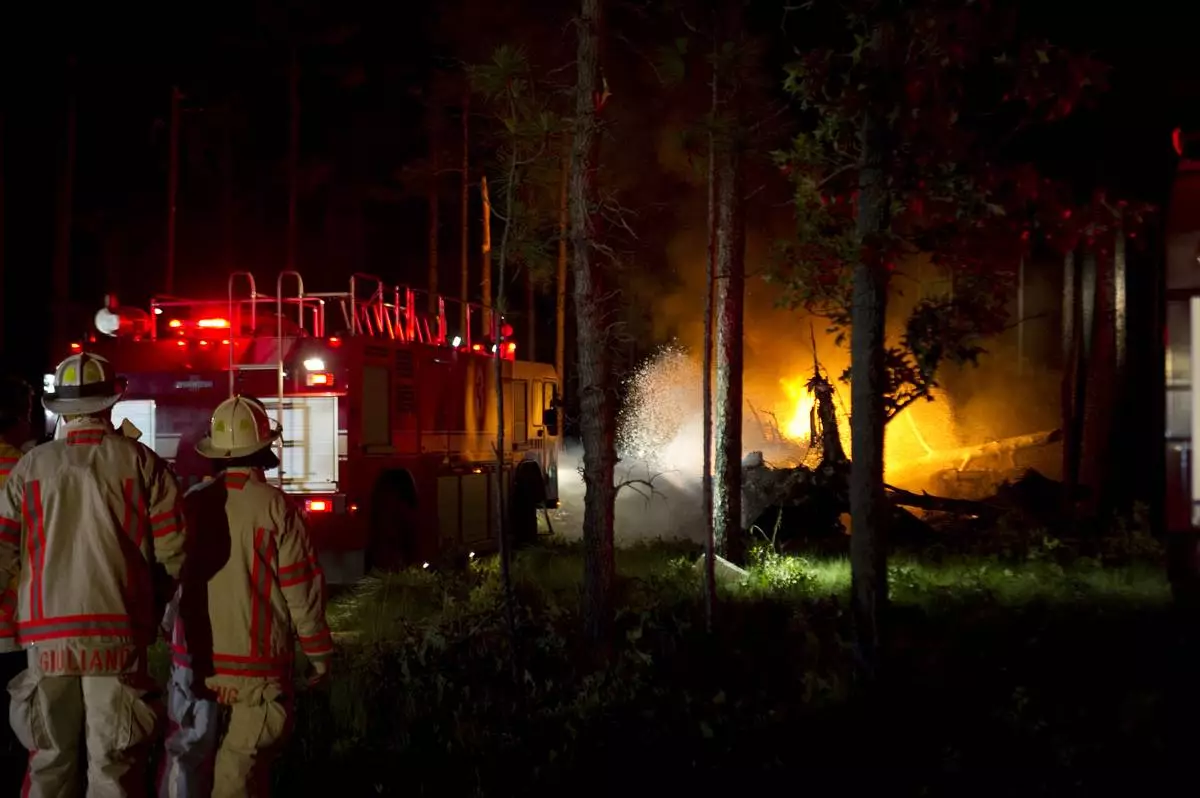
Local emergency responders extinguish the fires caused by a CV-22 Osprey crash that occurred at Eglin range June 13, 2012 near Eglin Air Force Base, Fla. (Airman 1st Class Christopher Williams, U.S. Air Force via AP)
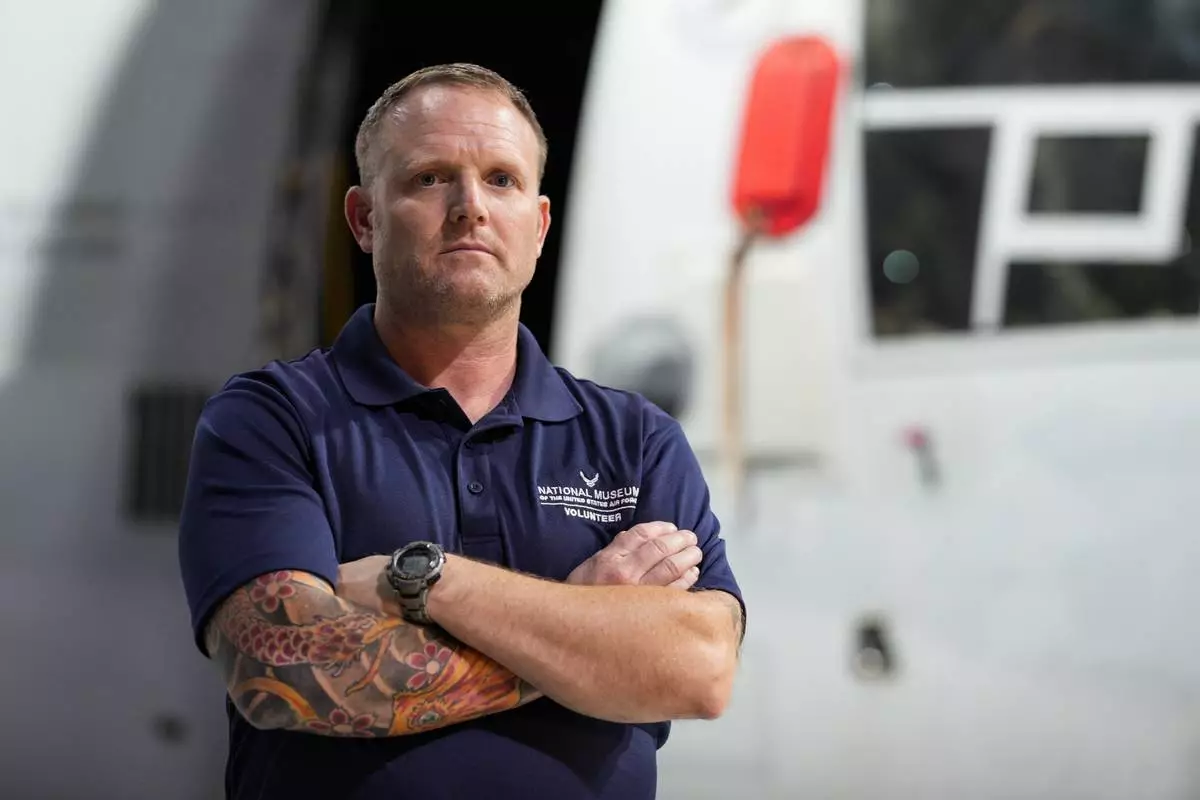
Former Air Force Osprey pilot Brian Luce poses for a portrait inside of the Wright Patterson AFB Air Force Museum, Aug. 9, 2024, in Dayton, Ohio. (AP Photo/Jeff Dean)
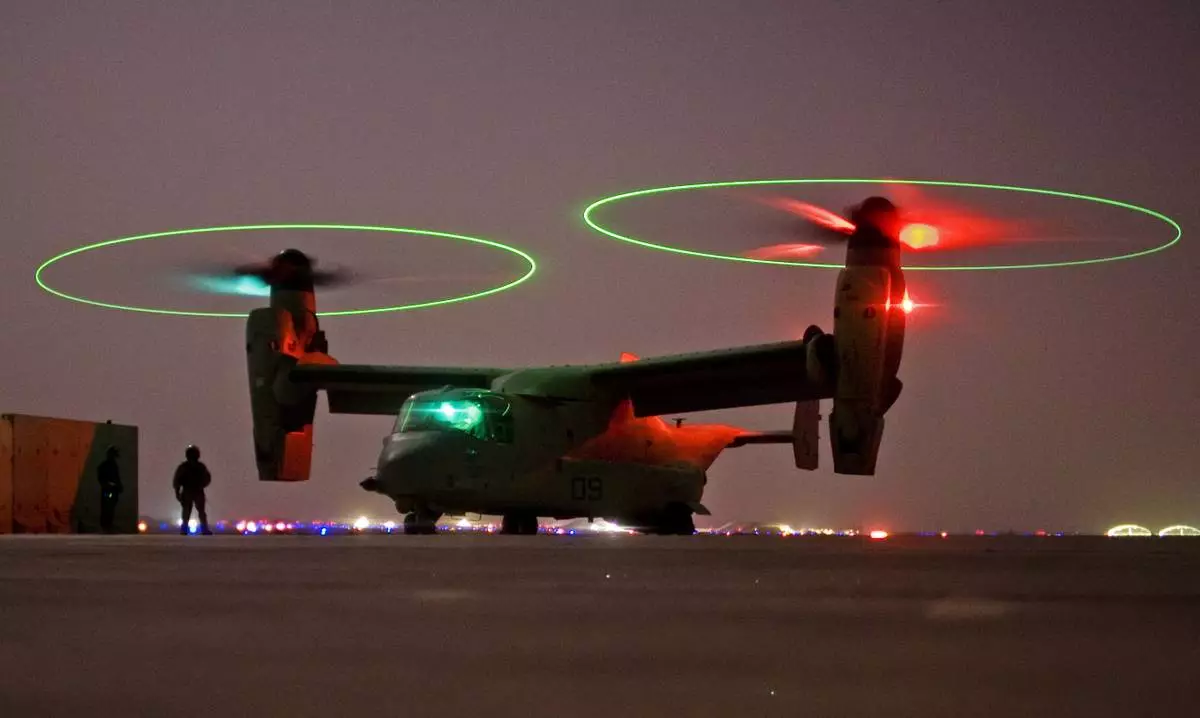
FILE - A V-22 Osprey tilt rotor aircraft taxi's during a mission in western Iraqi desert, Oct. 13, 2008. (AP Photo/Dusan Vranic, File)
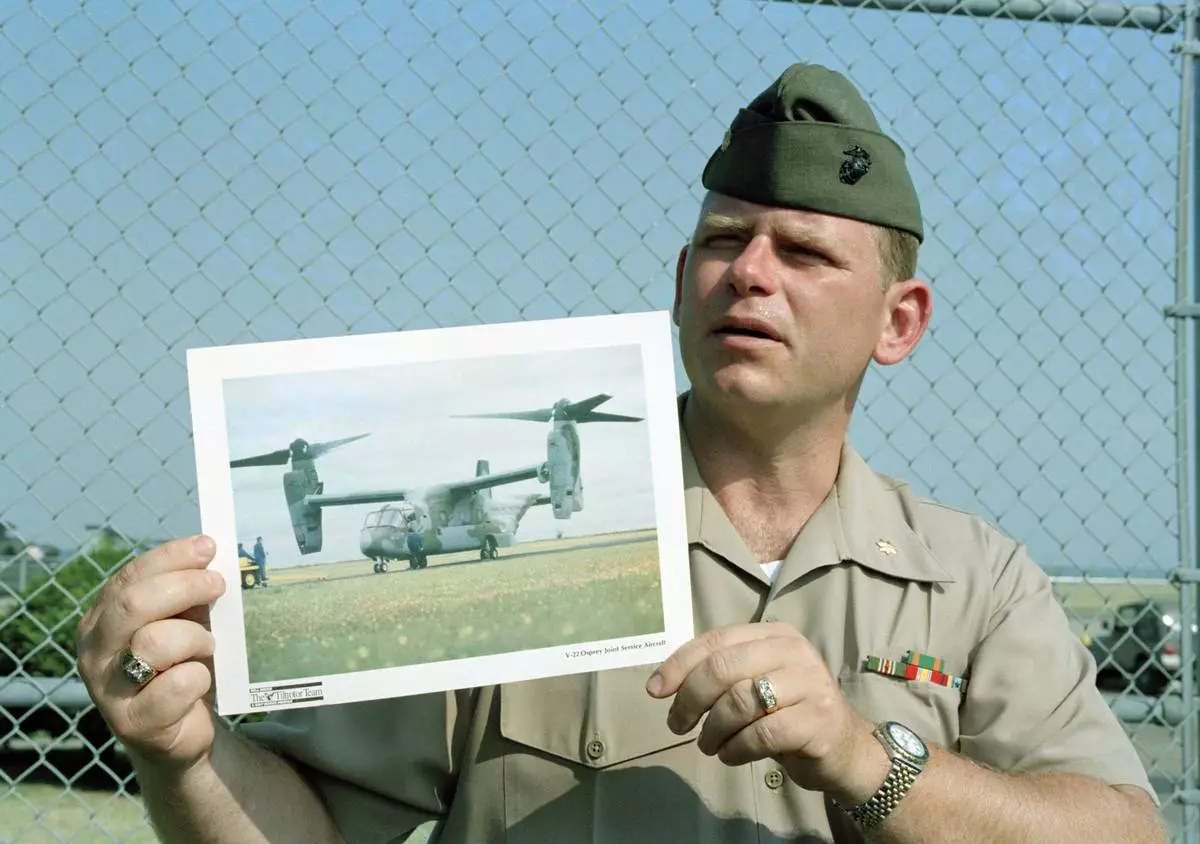
FILE - Maj. Barry Moore shows a photo of a V-22 Osprey aircraft at a news conference, July 20, 1992, at Quantico Marine Air Station in Quantico, Va., after an experimental V-22 tilt-rotor aircraft crashed into the Potomac River near the air station. (AP Photo/Charles Tasnadi, File)
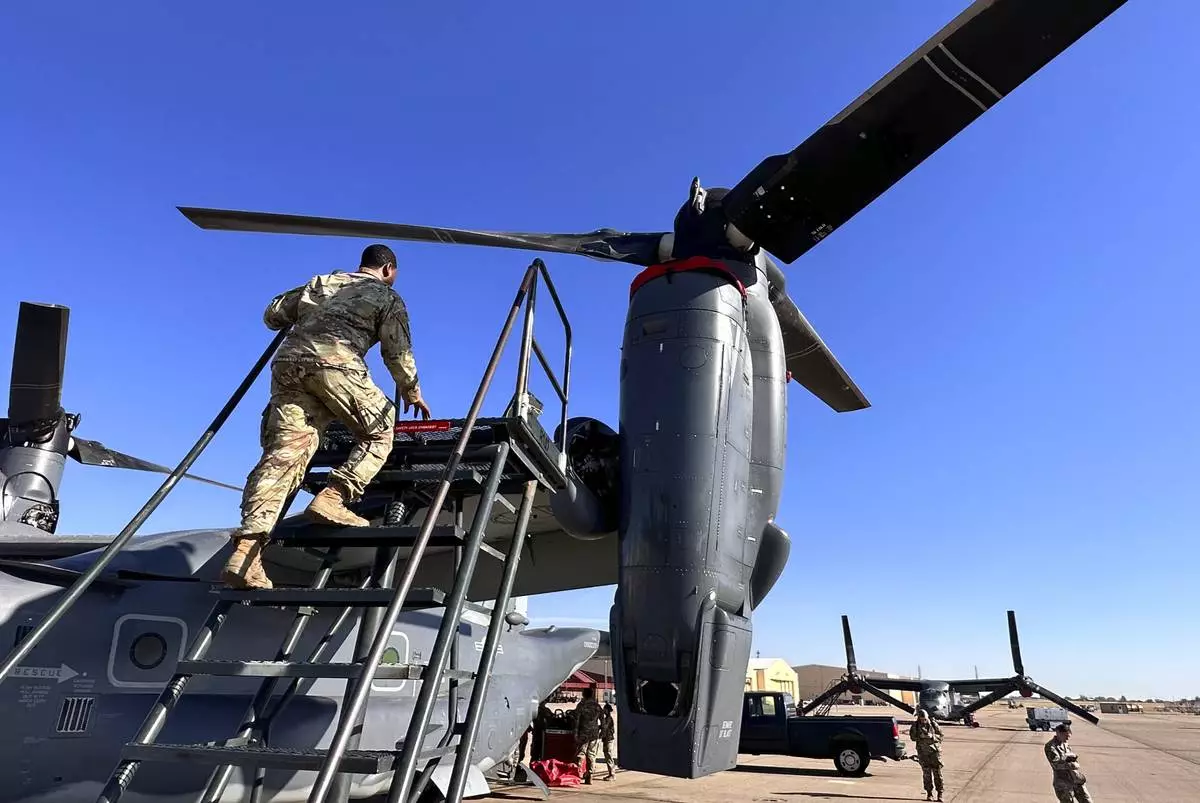
Master Sgt. Frank Williams, the production superintendent of the 20th Special Operations aircraft maintenance squadron at Cannon Air Force Base, N.M., climbs a ladder to show where hydraulic lines at the joint of the rotating engine and transmission need to be checked on the Osprey after flights, Oct. 8, 2024. (AP Photo/Tara Copp)
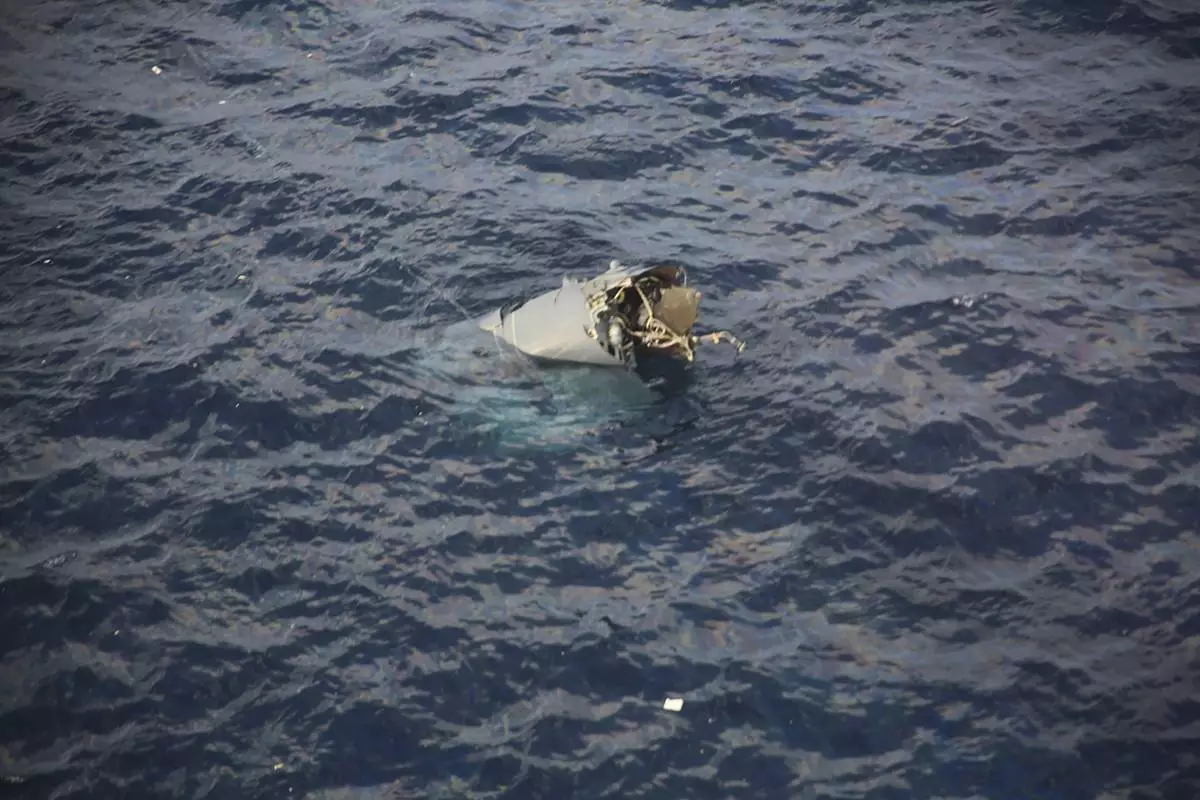
In this photo provided by Japan Coast Guard, debris believed to be from a U.S. military Osprey aircraft is seen off the coast of Yakushima Island in Kagoshima Prefecture in Japan Nov. 29, 2023. (Japan Coast Guard via AP)
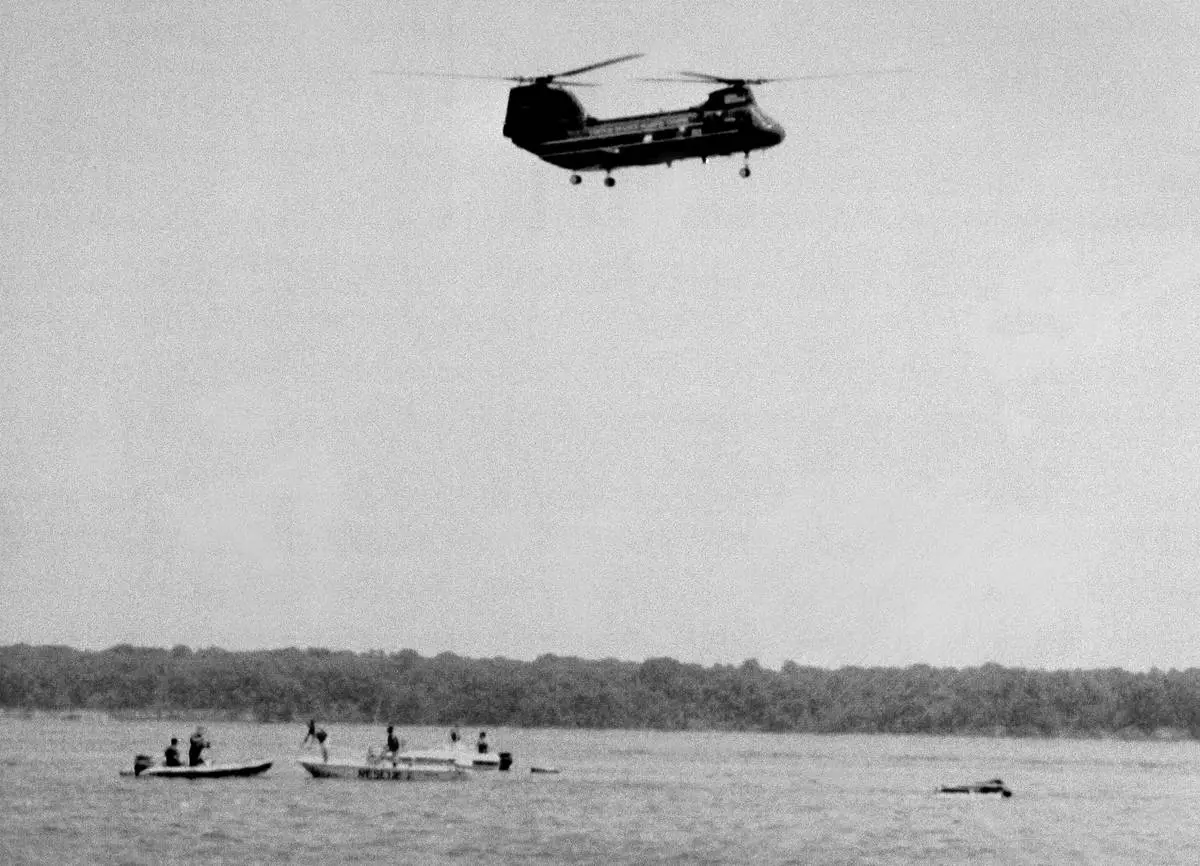
FiLE - Military rescue workers and boaters arrive on the scene of a crash, shortly after it happened, of an experimental V-22 Osprey tilt-rotor aircraft in the Potomac River just off the Quantico Marine Air Station, July 20, 1992, in Quantico, Va. (AP Photo/Bill Kramer)
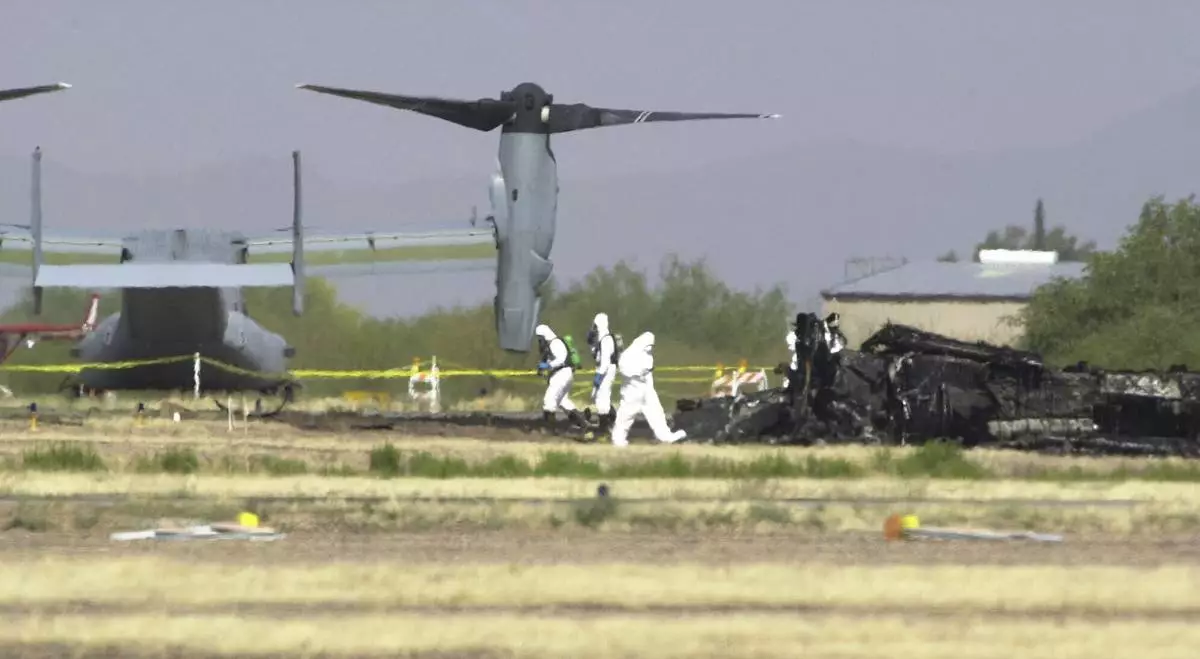
FILE - White suited workers investigate the crash scene of a Marine Corps MV-22 Osprey at the Avra Valley Airport, north of Tucson, Ariz., April 9, 2000. A Marine Corps aircraft attempting to land during a nighttime training mission crashed and burst into flames, killing all 19 aboard and adding to a checkered history for a new breed of hybrid plane that can take off and land like a helicopter. (AP Photo/Jon Hayt, File)
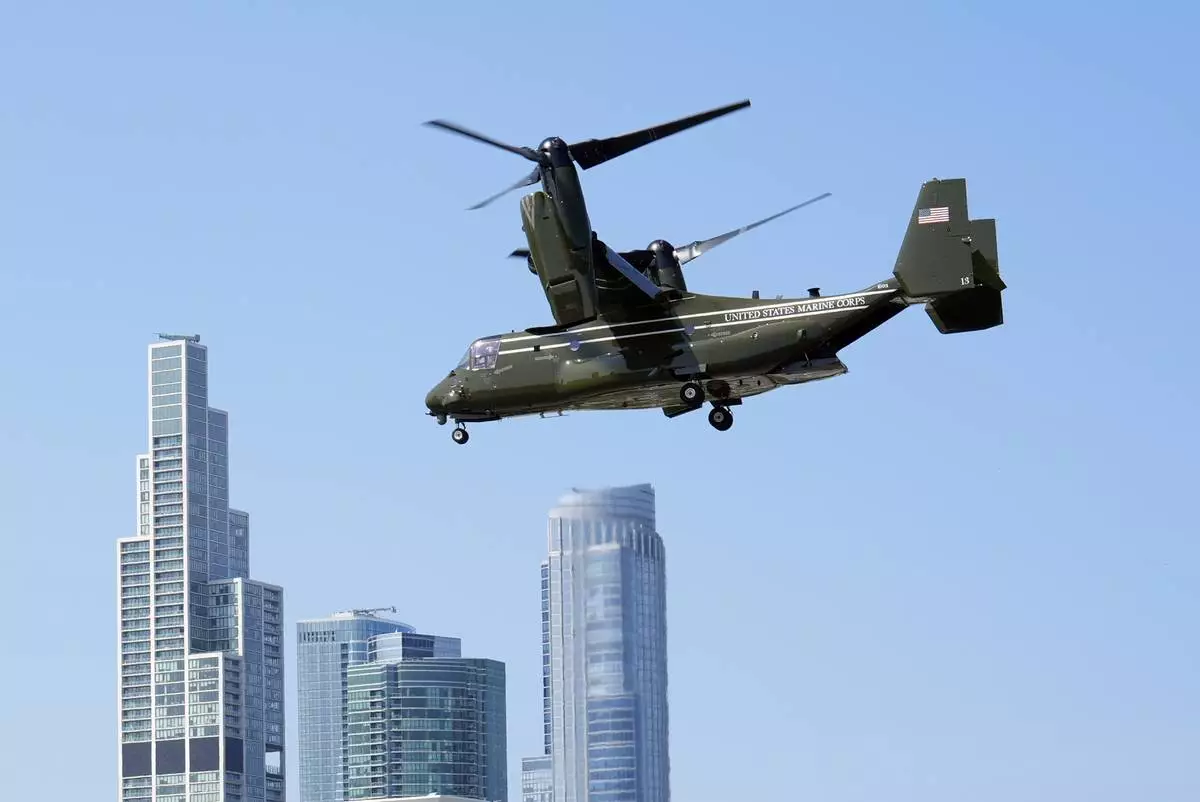
Marine Two, an Osprey tilt-rotor aircraft, with Vice President Kamala Harris and second gentleman Doug Emhoff aboard, lifts from Soldier Field in Chicago, Aug. 23, 2024.(AP Photo/Jacquelyn Martin)
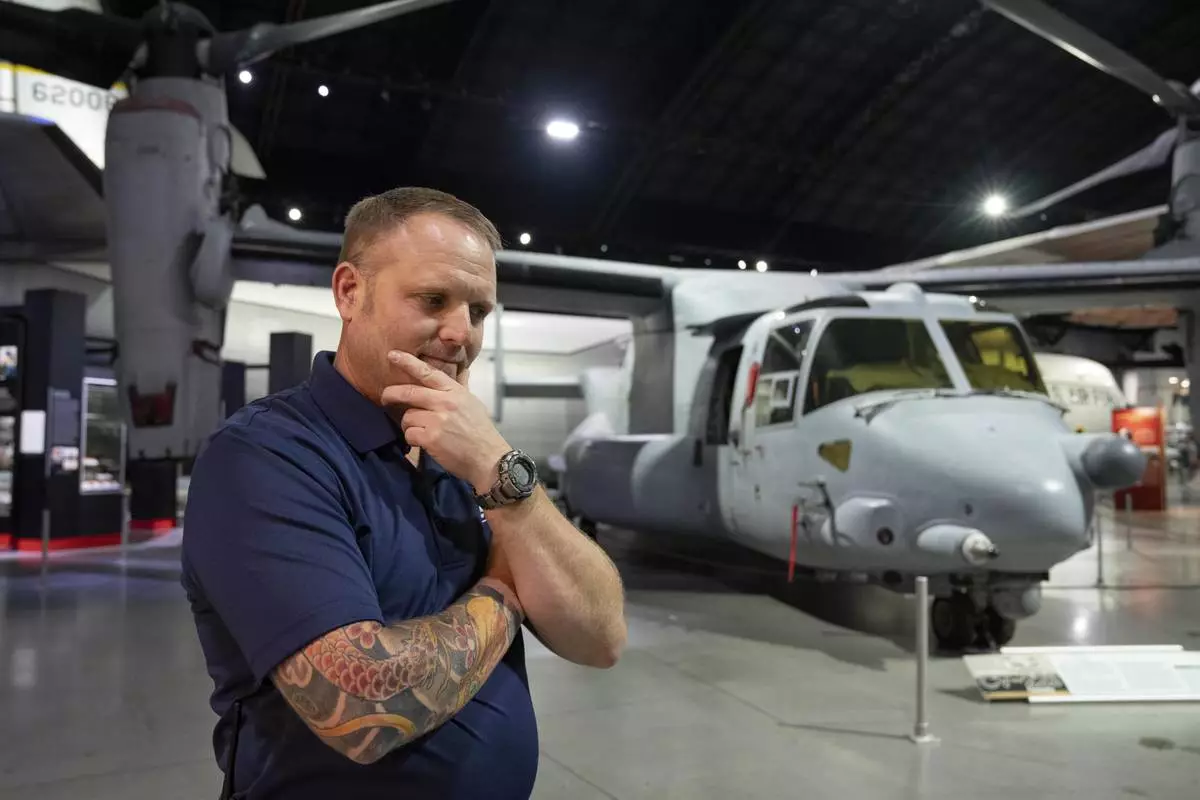
Former Air Force Osprey pilot Brian Luce poses for a portrait inside of the Wright Patterson AFB Air Force Museum, Aug. 9, 2024, in Dayton, Ohio. (AP Photo/Jeff Dean)
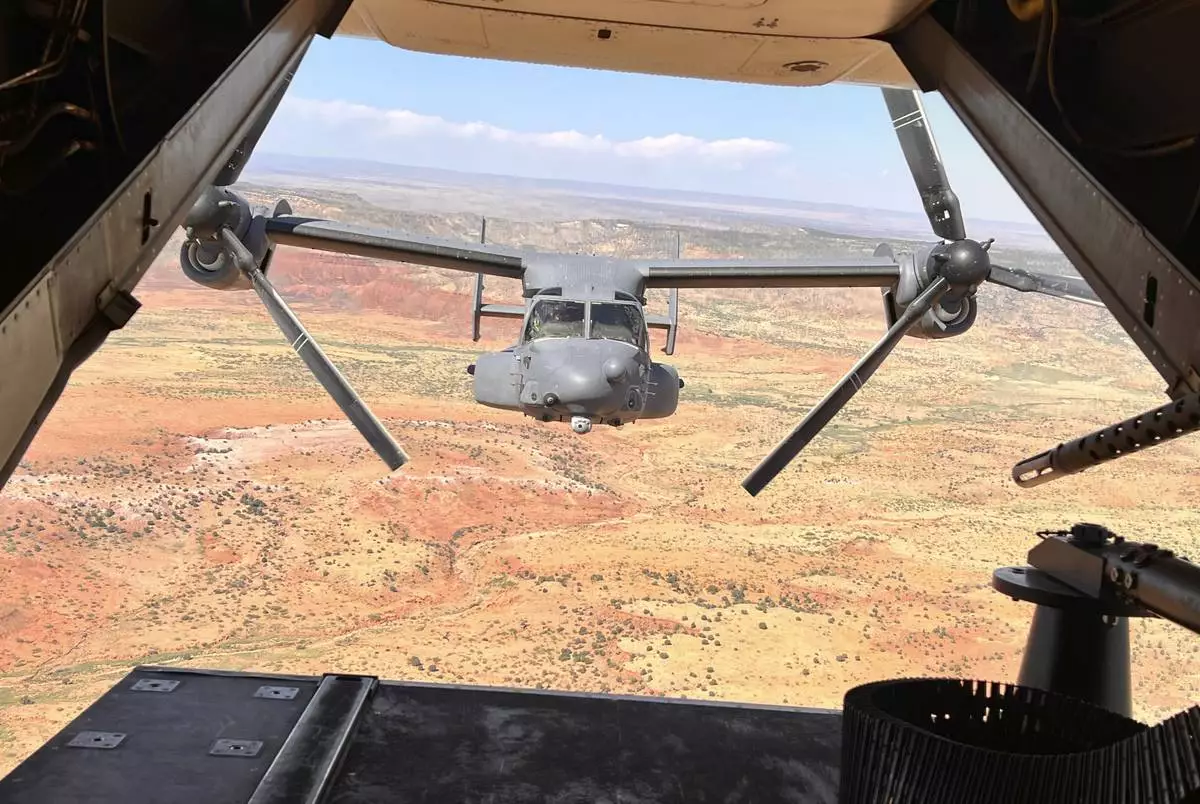
Two Air Force Special Operations Command CV-22B Ospreys fly low and fast in formation on a training range named the Hornet at Cannon Air Force Base, N.M., Oct. 9, 2024. (AP Photo/Tara Copp)






